


Ultimate Golf Club Distance Chart for Seniors [All Skill Levels]
Our website is supported by our readers. We may receive commissions when you click our links and make purchases. For more details see our disclaimers page .
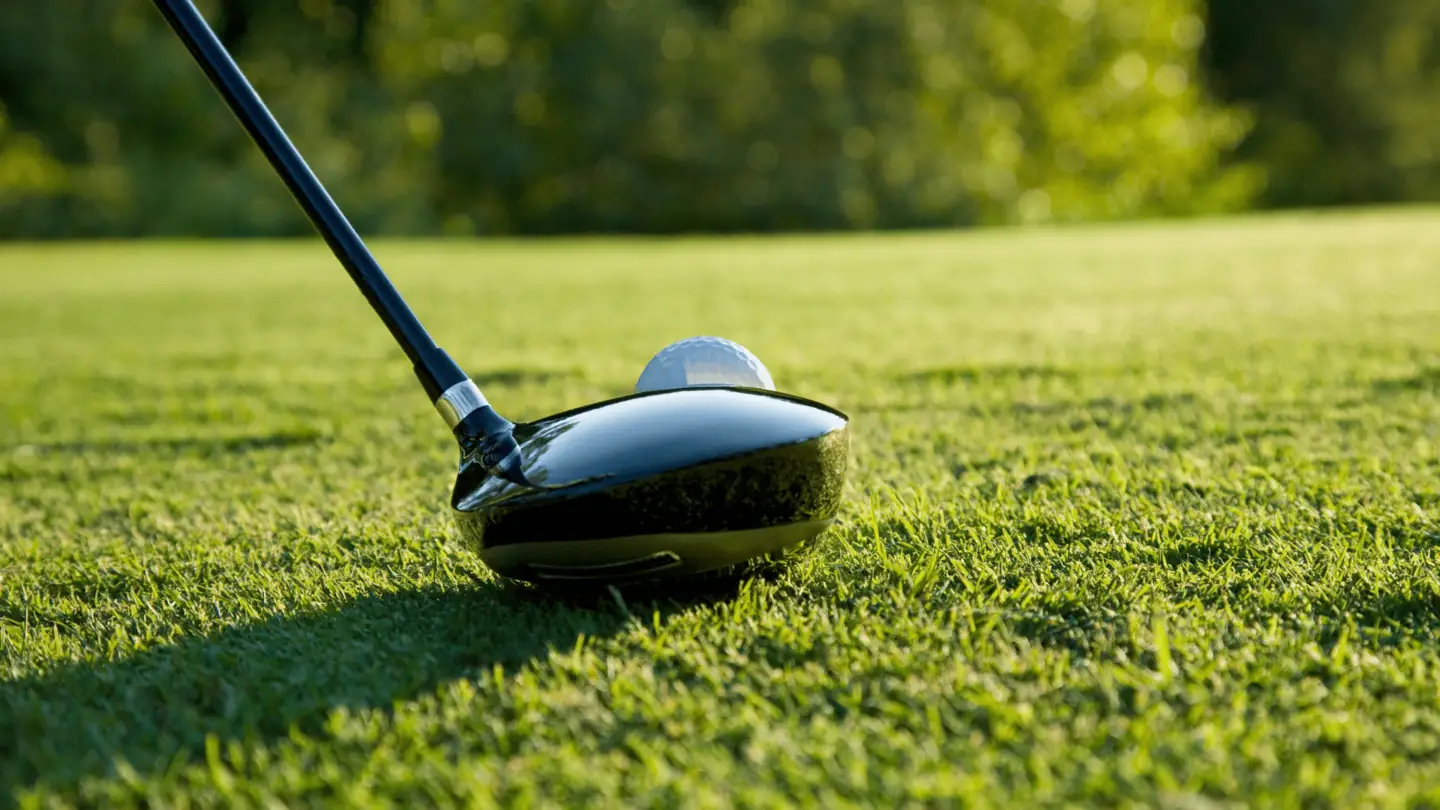
Table of Contents
Regardless of age, any golfer’s shot distance is a significant concern. So a golf club distance chart for seniors holds the same importance at any age.
As we get older, our performance on the golf course naturally changes. You might control some elements to an extent through exercise and nutrition , but certain factors are part of aging.
So logically, you shouldn’t be comparing how you play to those who don’t experience the same limitations as you.
Senior golf has its standard for what poor or great performances are. You should judge your skill level based on your group. You can look at distance charts to get an idea of the average distance players in your category.
This article will give you the best golf club distance charts for seniors.
🏌️♂️ Read Next: 13 Best Golf Clubs for Seniors [Expert Buyers Guide]
Golf Club Distance Chart Utilization
Distance charts essentially give the average distance covered by a club. Different charts focus on variable factors such as gender, age, experience, etc.
A golf club distance chart shouldn’t be viewed as a benchmark. It’s a helpful tool to compare your performance realistically, considering limiting factors. So don’t sweat it if your numbers don’t match the charts.
The better approach is knowing your yardage rather than focusing on how far each club can go. Different people get different numbers for the same club, so while a 7 iron is going far for your friend, maybe your 5 iron covers the same ground.
What I’m stressing about is that it’s all relative. Contrary to popular belief, being a long-hitter doesn’t guarantee a lower score. It’s understandable why people assume that long shots travel a greater distance, possibly lowering your score.
But that’s just not written in stone. A short-hitter could outdo you. It’s just a matter of knowing yourself and your skill.
😂 Read Next: 70+ Super Funny Golf Sayings That Will Keep You Laughing
Golf Distance Charts for Men & Women
First, we will look at the average distance that younger players of both genders cover. This gives an idea of how well a player can perform when all age factors are in their favor.
You can take these numbers as the upper limit of how much yardage one can achieve.
Golf Club Distance Chart for Men

With experience, male golfers gain decent yardage in their shots. The more players practice, the higher they can take their swing speed, which is critical for covering long distances.
You can compare your performance with the table below (average golfer to pro).
Golf Club Average Distances of Women
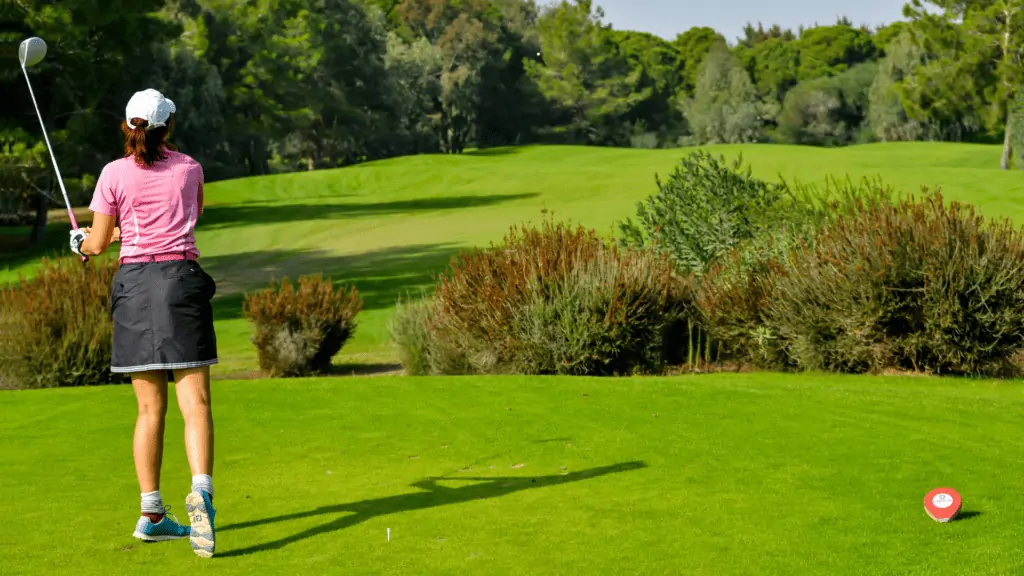
For female players, the numbers are lower than for male players. Many factors come into play here, such as thinner and shorter clubs coupled with a slower swing speed. The distances covered are impressive nonetheless.
You can use the table below as a reference point for your yardage.
Golf Club Distance Charts for Seniors
Players who are 50+ in age fall under the Seniors category. They’re eligible to play in the Senior PGA Championship , on top of the PGA Tour .
Although they aren’t required to leave the PGA Tour, it’s clear that their performance will eventually fall behind over time than the younger players on the golf course. But that’s just how life goes.
Nonetheless, here’s a shocking fact. The world record for the longest drive is held by 64-year-old, Mike Austin . He hit a 515-yard drive in 1974! We didn’t even have the TaylorMade SIM 2 back then.
Regardless, there’s a significant gap in golf club distances among senior players. Those who play recreationally are shorter hitters compared to Senior PGA Tour players.
You can make the comparison through the table below.
Golf Club Distance Charts by Age | Drivers, Fairway Woods & Irons
Below you’ll find a breakdown of the average golf distance chart for irons and drivers by age.
While you may notice, there is a stark difference in average club distances between younger and senior players. Professional golfers don’t rapidly lose their yardage because of old age.
Those who maintain their athleticism and continue playing stay in great shape. As Gary Player would agree, a lot can be done with a solid fitness routine. However, they’ll notice a slow dip in their numbers.
To understand the gradual shift in yardage, the table below shows the age-by-age decrease in shot distances.
Please note this golf club distance chart doesn’t account for whether a player is a professional.
Tips to Improve the Average Distance Golfers Hit

As a golfer, you can’t expect to stay on top of your game if you aren’t consistent.
Many skills you learn will get rusty as the years go by. If you’re not paying attention, it can become harder to play as you used to.
To help you overcome your short yardage on the golf course, here are a few points you can focus on.
Read Next: Closed Coil Golf Swing for Seniors: 4 Quick Steps & Drills ⛳️
1. Use the Proper Golf Equipment for Senior Golfers
Your golf balls and clubs are both determinants of your performance. You should ensure you’re using the suitable fit for you and the level at which you play.
Sometimes, your previous club preference doesn’t give you the same results as it once did. This may be a sign to try other clubs and see if there is another that suits you better. The same goes for golf balls.
Having the right driver and irons is as important as possessing the right skills.
2. Improve Your Golf Grip & Posture
To start, it’s essential to have the best golf grips for seniors .
As we age, a golfer’s grip and posture are often neglected parts of physical fitness.
Players focus more on stamina, strength, and similar capabilities, but other factors equally influence their performance.
A good golf grip helps you transfer strength and control the ball. You may struggle with this at first, but it could be what’s holding you back.
As for posture, ensure that you’re standing as tall as you can and are bending from the waist, not the shoulders. You should also be careful about your alignment, which your posture can throw off.
⛳️ Read Next: 23 Best Golf Tips For Seniors to Enhance Your Game
3. Improve Your Golf Swing Speed
One of the many culprits for a shorter distance on your shots is your swing speed. This is essentially how fast your club moves before it hits the golf ball.
Your swing speed changes over time. In the table below, you can see what male and female golfers average at different ages.
As you can see, as we all age, we tend to have slower swing speeds. However, golf training aids and exercise can help with increasing swing speeds.
Frequently Asked Questions
How far should a 60 year old man hit a golf ball.
According to the senior distance chart, a 60 year old man, should hit approximately 211 yards with his golf driver.
Final Thoughts | Golf Club Distance Chart for Seniors
The finest aspect of golf is that age is not a limitation. You grow as you go, adapting your expertise according to your circumstances.
Using a golf club distance chart for seniors as a reference, you can continue enjoying your game and be motivated to progress further.
If you are looking for motivation, check out Gary Player’s amazing fitness routine .
Related Senior Golf Articles
10 Best Golf Swing Tips for Seniors That Actually Work
13 Best Golf Clubs for Seniors in 2023 [Expert Buyers Guide]
Ultimate Guide to the Senior Golf Tour: 5 Major Tournaments
The 6 Best Golf Grips For Seniors In 2022
7 Best Drivers For Senior Women To Increase Distance in 2022

Erin has spent over 17 years as a healthcare executive working with seniors in nursing homes, skilled nursing, assisted living, and independent living communities. She also holds a Masters Degree in Social Work and other advanced degrees related to seniors.
Erin grew up playing golf in a family of golf fanatics. She started this site to help others add more enjoyment to the game of life through golf.
X (Twitter) | LinkedIn | Facebook | YouTube | Pinterest
1 thought on “Ultimate Golf Club Distance Chart for Seniors [All Skill Levels]”
thank you. some ideas and some information.
Leave a Comment Cancel reply
Save my name, email, and website in this browser for the next time I comment.
© 2024 Senior Golf Source

What Drives the Senior Tour Pros? Most Popular Driver on Champions Tour (2024)
Written by Graeme Hay | Last Updated: 28/04/2024
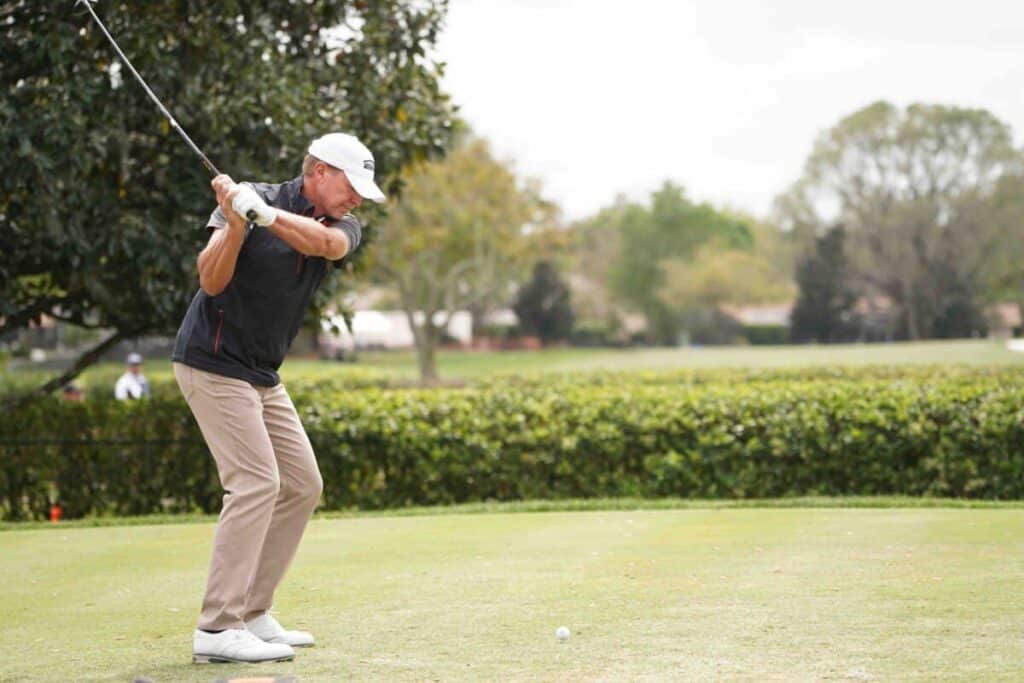
We have looked in the past at the clubs and drivers the top PGA Tour players use but given the distances they hit the ball are on a different planet to regular amateurs we wanted to see whether more can be learned from the most popular drivers used by Champions Tour pros.
Although the average driver swing speeds on the senior tour are still over 106mph – and therefore well above the average male amateur’s at 93.4mph – it is still closer than the 115mph average on the main PGA Tour.
So taking a in-depth look at the details of the drivers used by the best Champions Tour pros this is what we found.
PING’s G430 LST and TaylorMade’s Stealth Plus are the most popular drivers on the Champions Tour according to data available. Miguel Angel Jiménez and John Daly are G430 LST users while Fred Couples chooses the Stealth Plus. Titliest’s TSR3 and Callaway’s Rogue ST and Paradym Triple Diamond are the next most used models.
Basic makes and models of driver only tell us so much however so we didn’t just stop there and did a detailed analysis of the lofts the best pros on the senior tour are playing together with the specs of the driver shafts they use.
And finally we took a look at who was sponsored by which manufacturer to get an idea of how that factor potentially influences the driver choices among the top Champions Tour pros.

Most Used Drivers On the Senior Tour? Callaway Lead the Way
Driver data for the PGA Champions Tour is not as readily available as on the main PGA Tour.
So when we looked at the details of the drivers being used by the top 100 pros on the senior Tour to find which were the most used we were only able to find complete driver data for just over half – 51 to be exact – of this elite group.
In total we found 30 different driver models of driver being used among the 51 Champions Tour pros we found driver information for among the top 100 and when it came to the different brands being chosen this is what our detailed analysis found.
Callaway drivers are the most used on the Champions Tour with 33% of the senior pros analysed using them, including Steve Stricker. PING models are the next most popular picked by 27%. TaylorMade and Titleist drivers are each chosen by 13% with Tour Edge used by close to 10%. Japanese brand XXiO is used only by Ernie Els.
Callaway and PING therefore clearly dominate this group accounting for 31 of the 51 drivers we found in play with TaylorMade, Titleist and Tour Edge models making up the vast majority of the rest.
What was interesting to note though was that while Titleist are the dominant force among the drivers used on the PGA Tour their models are a much less popular choice among the top pros on the Champions Tour.
A key question of course when it comes to driver choices by all the pros however is of course how much it is influenced by sponsorship deals.
Once again the data available on Champions Tour pros is not nearly as abundant as on the PGA Tour but our analysis found 45% of the 51 senior pros we researched playing the same driver model as one of their sponsors.
In all likelihood this number is potentially higher however there were clear examples, including the great Bernhard Langer – who carries six different brands of club in his bag – that sponsorship is not always the overriding factor when it comes to the driver choices the senior pros make.
Further while the dominant driver makes and models among the best senior pros may be a bit different to those found on the main Tour what is clear though, when you look in detail at the drivers the Champions Tour pros use, is that they go into just as much detail when it comes to the exactness of their driver set up.
Just as on the PGA Tour each driver is clearly custom-fitted to a precise extent for each player and even though we found 5 PING G430 LST drivers being used you can be sure there will be a unique set-up for each pro.
Not only that certain players carry more than one driver around the Champions Tour with them switching between the two, or even three, depending on the conditions of the course they are playing that week or simply due to them having more confidence in one than the other at a particular time.
Dickie Pride for example carries a PING G410 Plus around with him in addition to the Callaway Rogue ST he typically puts in play while Brian Gay also has a Cobra LRDx LS in his bag together with a TaylorMade Stealth Plus.
“Nobody has ever noticed it and I’ve been doing this for three years. Every other club I use a single overlap grip. On my driver, I use a double overlap.” Padraig Harrington, 2022 US Senior Open Champion and ranked 1 in driving distance on 2023 PGA Champions Tour
Steve Flesch by comparison carries not two but 3 different models of the Callaway Rogue ST driver family allowing him to alternate between the standard Rogue ST Max and the draw-biased Max D and LS (‘low spin’) options.
It is also noticeable that not all the Champions Tour pros we found data for are immediately moving to the latest model of their preferred brand of driver and continue to play with older driver models.
Doug Barron continues for example to use his old trusty TaylorMade Stealth driver because he says he “hits it 15 yards longer than anything else I tried.”
And that search for distance also caused us to notice another couple of quirks among the top senior pros.
Padraig Harrington topped the driving distance charts on the Champions Tour in 2023 with an average total distance of 302.4mph.
Incredibly to do this Harrington has increased his driver swing speed to measurements of 120mph and above on the Champions Tour up from the 116 mph speeds he was recording when he was winning both the 2008 British Open and USPGA at the peak of his golfer powers.
But not only that he also employs a ‘baseball’ style grip only when using his driver – he uses a standard overlap grip for all his other clubs – in an effort to release a little extra energy into the driver clubhead for more overall power.
You can see him doing this in the video below and given his driving distance numbers as he enters his 50s it is clearly working!
What Driver Loft Do Senior Pros Use? It Typically Starts with 9 or 10.
When we looked at the degree of driver the top pros on the PGA Tour use we were immediately struck by the variance and precision in driver lofts they chose to put in play.
And when it comes to the best pros on the PGA Champions Tour it appears they are equally as exacting in their approach.
9 degrees is the most used driver loft among the Champions Tour pros for which data is available with 24% setting up with it, including Padraig Harrington. 10.5º is the next most popular loft with 1/5 choosing it. 2023 Tour winner Steve Stricker chooses an 8º driver while 6º is the lowest driver loft used by Brian Gay.
It is common of course for top pros on all the major tours to change the loft of their driver on occasion depending on the course set-up they are playing on any particular week and this is again noticeable on the Champions Tour.
Kirk Triplett, for example, has a 9º and 10.5º PING G425 Max driver in his golf bag but for other senior pros, changes extend to carrying more than one driver of both different lofts and models.
For Dicky Pride this means taking an 8º PING G410 Plus driver around on the Champions Tour with him alongside his more regularly used 9º Callaway Rogue ST driver.
Brian Gay meanwhile, while typically putting the lowest lofted driver on the tour in play with his 6º TaylorMade Stealth Plus also carries a 7.5º Cobra LTDx model in his bag to use on different occasions.
Interestingly however we found no difference in the variance in driver lofts used by different age groups of the top 100 on the Champions Tour and as such their loft choices did not appear to be affected by this factor.
What Driver Shaft is Most Used on the Champions Tour?
When it comes to driver shafts pro golfers are very exacting and our analysis of the shafts the top senior pros put into the biggest club in their bag again found this in evidence.
Among the 51 of the top 100 Champions Tour pros for which we found driver data we discovered 29 different models of driver shaft being used.
Fujikura’s Ventus Red 6X and Black 6X driver shafts are the most popular on the Champions Tour with nearly 1/4 of senior pros using one. The Ventus Blue 6X is the next most popular alongside PING’s Tour 65 S shaft chosen by 6%. Graphite Design’s Tour AD DI and IZ 6X shafts are the third most common with close to 5% picking them.

According to our analysis the driver shaft choices of the top Champions Tour pros map almost identically to those on the main tour with the Fujikura Ventus Black 6X topping the charts among the top 100 on both these tours.
We did find more variety of driver shafts on the PGA Tour compared to the Champions Tour however given the variety of shaft choices we found in this research the senior pros are clearly just as exacting when it comes to making their driver shaft choice.
Kevin Sutherland interestingly for example carries two models of his 10.5º PING G425 LST with two different shafts in them.
One is fitted with an extra stiff flex Ventus Red 6X while the other has a stronger True Temper’s Project X HZRDUS Smoke Red RDX 60 TX flex shaft in it.
And the two versions of the same driver we noted above that Kirk Triplett is using don’t just have different lofts but also slightly different shafts in them.
While his 10.5º PING G425 Max has an Aldila Tour Blue 60 TX shaft the 9º model of the same driver he has in his bag has a slightly heavier Tour Blue 70 TX shaft in it.
Steve Flesch meanwhile takes things even further choosing 3 different shafts from 3 different manufacturers – True Temper, Graphite Design and Fujikura – in the three different models of the Callaway Rogue ST driver family he alternates between.
So just like their colleagues on the main tour the senior pros are tinkering just as much when it comes to driver shafts although it is interesting that although like on the PGA Tour Fujikura was the top driver shaft brand Mitsubishi shafts were fifth most used on the Champions Tour drivers we found data for.
This compares to its position as the second most popular choice of driver shaft brand on the main tour.
On the Champions Tour by comparison behind Fujikura’s position as the dominant driver shaft brand Graphite Design shafts are the second most popular with 16% using them.
True Temper shafts are the 3rd most common with just under 12% choosing them with PING in 4th place with 6% picking their Tour 65 S shaft.
Mitsubishi driver shafts by comparison are the choice of only 2% of this Champions Tour group we analysed compared to their use by 1/4 of the top 100 pros on the PGA Tour.
Breakdown of Drivers Used by PGA Champions Tour Players
And finally just to give the full picture of how many and which pros are using which brand and model of driver here is the complete breakdown of the 51 drivers used by the top 100 Champions Tour pros we found data on in order of popularity.
Before you go …
Knowing what drivers the top Champions Tour players are using is interesting but with the driver swingspeeds of the average senior pro being well over 10mph faster than the average male amateur (106.6mph vs. 93.4mph) there is likely more to learn from the drivers being played by the best female pros.
So have a read of our next article to find out what drivers the best LPGA pros are choosing with their 94mph average driver swing speeds…
What Drivers Do LPGA Players Use?
Other top posts related to this topic:
- What Driver is Most Used On the PGA Tour? Top 100 Player Analysis
- Most Popular Driver on LPGA Tour? Top 50 Player Guide
- The Go-To Fairway Woods Of Senior Tour Champions
- Champions Hybrid Heroes. Most Used Hybrids By Champions Tour Pros
- Champions’ Choice: The Most Used Irons on the Champions Tour
- Flexible Friends: Uncovering The Shafts Champions Tour Players Use
- Behind Every Stroke: The Most Popular Putter On Champions Tour
- From Tee to Green: Analyzing What Golf Balls Champions Tour Pros Use
- In The Bag: Unpacking The Clubs Champions Tour Players Use
- What Clubs Do Pro Golfers Use? Top 100 PGA Tour Player Guide
- What Clubs do LPGA players use? Top 50 Player Breakdown
Leave a Reply Cancel reply
Your email address will not be published. Required fields are marked *
Save my name, email, and website in this browser for the next time I comment.
RECENT ARTICLES

Behind Every Stroke: The Most Popular Putter on Champions Tour (2024)

Champions Hybrid Heroes. Most Used Hybrids by Champions Tour Pros (2024)

The Go-To Fairway Woods of Senior Tour Champions (2024)

Flexible Friends: Uncovering the Shafts Champions Tour Players Use (2024)

In the Bag: Unpacking the Clubs Champions Tour Players Use (2024)
LEGAL INFORMATION
This site is owned and operated by Golfing Focus Limited, a private limited company whose registered office is in London, UK. Golfing Focus Limited is a participant in the Amazon Services LLC Associates Program, an affiliate advertising program designed to provide a means for sites to earn advertising fees (at no cost to you) by linking to Amazon.com. Golfing Focus Limited also participates in other affiliate programs with the eBay Partner Network, FlexOffers, CJ.com, Svorn and other sites and is compensated for referring traffic and business to these companies (again at no cost to you).
Our Socials
Game Changers
How driving distance has changed over the past 40 years on the pga tour.
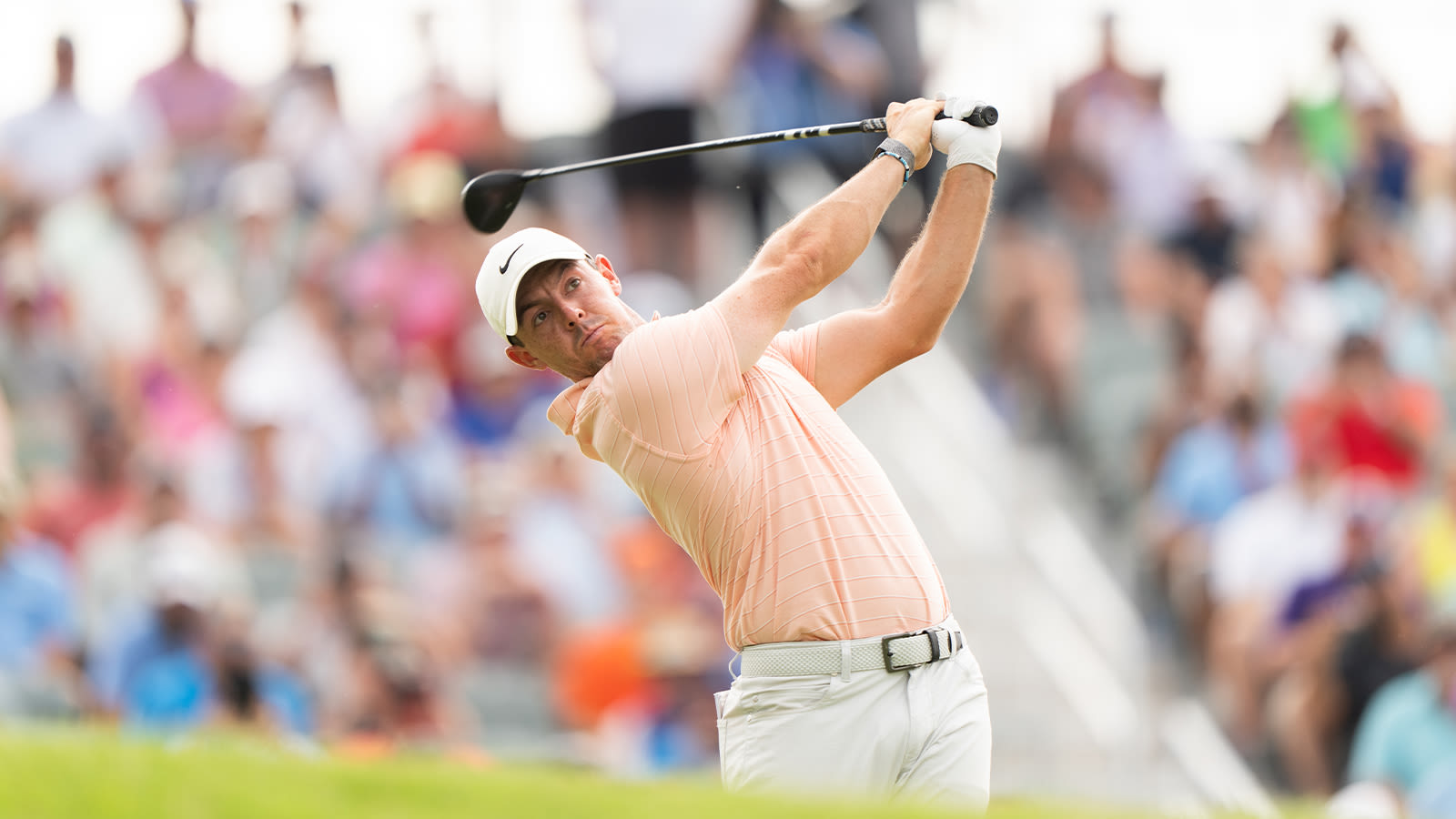
Rory McIlroy of Northern Ireland hits his shot from the tenth tee during the second round of the 2022 PGA Championship at the Southern Hills on May 20, 2022 in Tulsa, Oklahoma. (Photo by Darren Carroll/PGA of America)

We Can Learn from Rory's Admission; Make Sure The Changes You’re Making Fit Your Golf Game

Hit it Longer off the Tee with Joanna Coe

Adding Distance Off the Tee Like Cameron Champ Will Help Your Golf Game
Year - average distance (yards) | leader - leader's average.
- 2023 - 297.2 | Leader: Rory McIlroy - 326.6
- 2022 - 299.8 | Leader: Cameron Champ - 321.4
- 2021 - 295.3 | Leader: Bryson DeChambeau - 320.8
- 2020 - 296.4 | Leader: Bryson DeChambeau - 322.1
- 2019 - 293.9 | Leader: Cameron Champ - 317.9
- 2018 - 295.29 | Leader: Trey Mullinax - 318
- 2017 - 292.79 | Leader: Rory McIlroy - 316.7
- 2016 - 291.06 | Leader: J.B. Holmes - 314.5
- 2015 - 290.21 | Leader: Dustin Johnson - 317.7
- 2014 - 289.85 | Leader: Bubba Watson - 314.3
- 2013 - 288.00 | Leader: Luke List - 306.3
- 2012 - 290.07 | Leader: Bubba Watson - 315.5
- 2011- 291.14 | Leader: J.B. Holmes - 318.4
- 2010 - 287.49 | Leader: Robert Garrigus - 315.5
- 2009 - 288.07 | Leader: Robert Garrigus - 312
- 2008 - 287.74 | Leader: Bubba Watson - 315.1
- 2007 - 289.08 | Leader: Bubba Watson - 315.2
- 2006 - 289.35 | Leader: Bubba Watson - 319.6
- 2005 - 288.88 | Leader: Scott Hend- 318.9
- 2004 - 287.32 | Leader: Hank Kuehne - 314.4
- 2003 - 286.30 | Leader: Hank Kuehne - 321.4
- 2002 - 279.84 | Leader: John Daly - 306.8
- 2001 - 279.35 | Leader: John Daly - 306.7
- 2000 - 273.18| Leader: John Daly - 301.4
- 1999 - 272.45 | Leader: John Daly - 305.6
- 1998 - 270.63 | Leader: John Daly - 299.4
- 1997 - 267.67 | Leader: John Daly - 302
- 1996 - 266.49 | Leader: John Daly - 288.8
- 1995 - 263.55 | Leader: John Daly - 289
- 1994 - 261.84 | Leader: Davis Love III - 283.8
- 1993 - 260.36 | Leader: John Daly - 288.9
- 1992 - 260.52 | Leader: John Daly - 283.4
- 1991 - 261.44 | Leader: John Daly - 288.9
- 1990 - 262.75 | Leader: Tom Purtzer - 279.6
- 1989 - 261.81 | Leader: Ed Humenik - 280.9
- 1988 - 263.50 | Leader: Steve Thomas - 284.6
- 1987 - 262.50 | Leader: John McComish - 283.9
- 1986 - 261.58 | Leader: Davis Love III - 285.7
- 1985 - 260.18 | Leader: Andy Bean - 278.2
- 1984 - 259.61 | Leader: Bill Glasson - 276.5
- 1983 - 258.65 | Leader: John McComish - 277.4
- 1982 - 256.89 | Leader: Bill Calfee - 275.3
- 1981 - 259.66 | Leader: Dan Pohl - 280.1
- 1980 - 256.89 | Leader: Dan Pohl - 274.3
PGA of America
The PGA of America is one of the world's largest sports organizations, composed of PGA of America Golf Professionals who work daily to grow interest and participation in the game of golf.
PGA TOUR Player Stats 2021-22
- Statistics are updated nightly
- AGE : Current age of player
- EARNINGS : Official money won
- CUP : FedExCup Points
- EVNTS : Tournaments played
- RNDS : Rounds played
- CUTS : Cuts made
- TOP10 : Top 10 finishes
- WINS : Wins
- SCORE : Scoring average per round
- DDIS : Driving distance (in yards)
- DACC : Driving accuracy %
- GIR : Greens In Regulation %
- PUTTS : Putts per hole
- SAND : Save Percentage
- BIRDS : Birdies per round
- Terms of Use
- Privacy Policy
- Your US State Privacy Rights
- Children's Online Privacy Policy
- Interest-Based Ads
- About Nielsen Measurement
- Do Not Sell or Share My Personal Information
- Disney Ad Sales Site
- Work for ESPN
- Corrections
Search Golf Compendium
Golf compendium, pga tour driving distance leaders by year.

Popular posts from this blog
Golfers with the most wins in major championships, 2024 masters tournament winner and final scores.
24 Famous Golfers Who Were Photographed in the Nude
The CJ Cup Byron Nelson
TPC Craig Ranch
USGA/R&A release latest Distance Report: Here's what the numbers mean

Andrew Redington
While Wednesday’s announcement that the USGA and R&A have narrowed their focus on ways to dial back distance at the elite level might have gotten all the attention, the ruling bodies also issued their annual Distance Report at the same time.
In its simplest interpretation, the Distance Report has been used to chronicle the imbalanced role distance is playing at the elite level. At first glance, this latest report may not have been the most convincing document. Year over year, driving distance on the PGA Tour, the European Tour (now DP World Tour), the Korn Ferry Tour and the Japan Golf Tour decreased in 2021 compared to 2020. And while average distances on the PGA Tour Champions, LPGA Tour and LET showed increases, each was below or just fractionally above their respective all-time highs.
But the point the ruling bodies want to make with the document is the overall trendline, which clearly has been much more upward than stable over the last 30 years. The reports use 2003 as a benchmark since that marks the first full year after the ruling bodies issued a Joint Statement of Principles that put elite driving distances on notice.
MORE: The first step in a rollback? Governing bodies announce plan in curtailing distance
Since 2003, according to their research, the average driving distance has increased 3.2 percent from 2003-2021. Moreover, the document makes the case that the PGA Tour statistic measuring all drives (compared to the metric that only accounts for two measured holes) was up 1.5 yards to an all-time high of 289.9 yards. Still, on the measured holes on the PGA Tour, 97 percent of the shots were hit with a driver, validating that number as the best indicator of where distance truly stands.
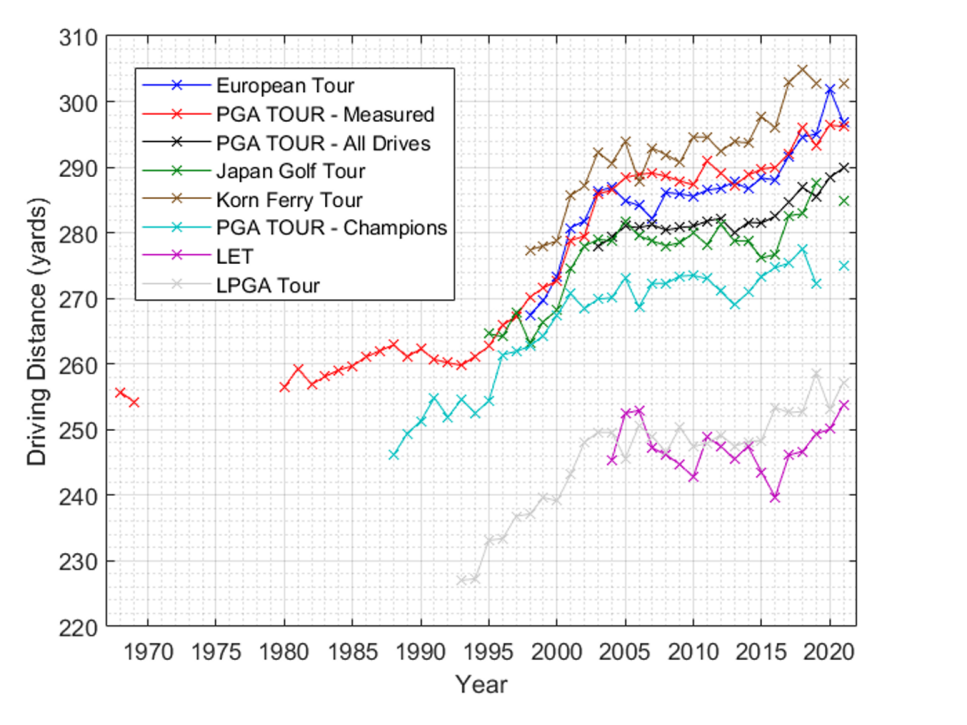
Also, not surprisingly, the bulk of drives are getting longer, according to the report. Since 2003, the percentage of drives less than 280 yards has decreased on both the PGA Tour and European Tour, while the percentage of drives greater than 300 yards has increased. In 2003, about 40 percent of drives recorded on the PGA Tour and European Tour were 280 yards and less, while slightly more than a quarter of drives exceeded 300 yards. By 2021, those percentages had more than flipped. In 2021, less than a quarter of drives didn't reach 280 yards, while about 43 percent were longer than 300.
The Distance Report also details data on PGA Tour clubhead speed, ball speed, launch angle and distance. Since 2003, average clubhead speed is up two mph, ball speed is up five mph, launch angle is slightly down and average spin rates also have decreased. In 2021, the average launch angle (10.5 degrees) and spin rate (2,527 rpm) were close to USGA golf ball testing averages (10 degrees, 2,520 rpm). While the average clubhead speed was 115.1 mph—about five mph short of the current clubhead speed used in the ball test—the 90th percentile for clubhead speed (120.1 mph) is now right in line with that test speed.
The Distance Report also tracks the changes in scoring average across all tours. While it, too, reflects improvement in the last 40 years, the report characterizes scores showing a "slow creep downward" of .04 strokes per year since 1980. Since 2003, it shows the scoring average on the PGA Tour is essentially unchanged.
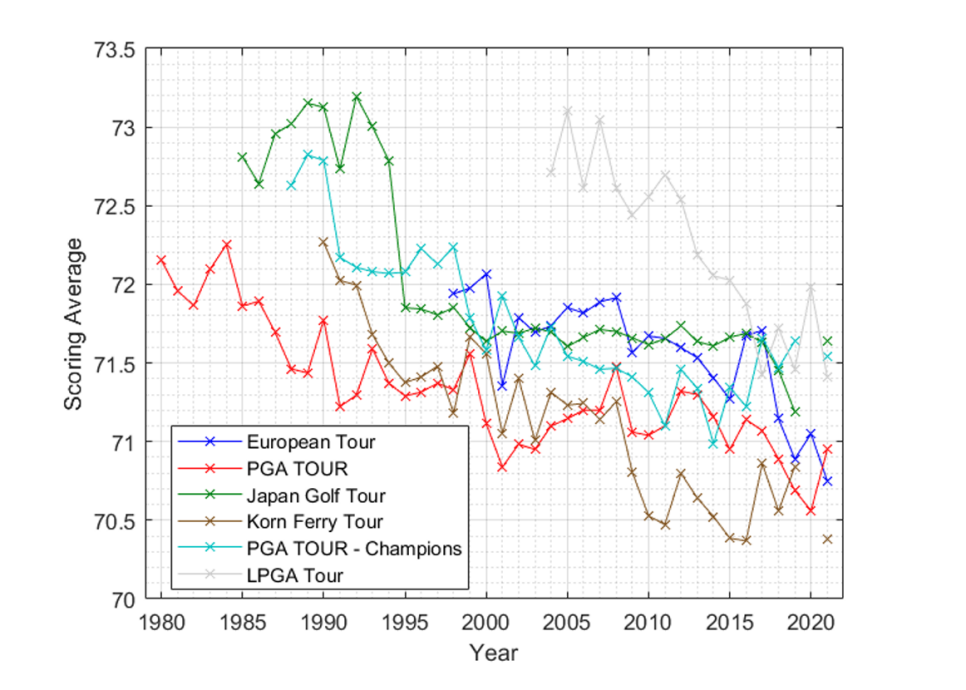
The ruling bodies' announcement on Wednesday of new “areas of interest” included the idea of raising the test swing speed of the golf ball’s Overall Distance Standard to “at least” 125 mph in order to more closely reflect tour player swing speeds. Data from the PGA Tour may indicate that 125 is about as rare as when the ruling bodies chose to update the test to a speed of 120 mph in 2004. This year, the average of the fastest swing speed each player on tour has recorded is about 119 mph.
Thomas Pagel, the USGA’s chief governance officer, said the Overall Distance Standard has adapted to the landscape of the elite men’s game as it has developed.
“We reflected on the intent of that rule to replicate the longest-hitting golfers at the time,” he said. “We just stepped back and observed what we’re seeing at the highest level today with the longest hitters, and recognized that 120 is no longer the number that replicates that. It was really, frankly, a reflection on history, and saying, ‘Are we at another moment in time where we need to go back in and revise this?’
“As for whether 125 is enough, we may find that 125 is not enough, or we may find that 125 is a good number. But 10 years from now, we need to plan on researching and looking at further change so that we can evolve and ensure that the rule continues to model or mirror what we’re seeing the longest hitters in the game doing.”
While the trend in driving distance is clearly upward historically, the rate of increase doesn’t seem out of whack with past numbers. The PGA Tour players may be hitting it 3.6 percent farther in 2021 than in 2003, but when compared to any other similar stretch of time, that rate is nowhere near the highest. In fact, it was the lowest ever recorded in any 18-year span and has been trending downward since 2012.
Then again, there is a fundamental difference between looking at the rate of growth in distance compared to the actual growth. In the last five years, distance on the PGA Tour is increasing at a rate of about a yard per year. That’s less than half what it was in the late 1990s and early 2000s, but more than double the rate from 1980-95. And when those increases are coming on top of a driving distance average that is in the mid-290s now compared to the low 260s then, that’s what has the ruling bodies concerned. It’s not the size of the distance gains, it’s that, at least to the ruling bodies, they don’t appear to be leveling off, despite all the equipment regulations. That’s especially concerning to them at a time almost two decades removed from their Joint Statement of Principles that declared “any further significant increases in hitting distances at the highest level are undesirable.”
The R&A’s Steve Otto, executive director-chief of technology, thinks any ideas about change aren’t simply a reaction to thwart new club and ball developments.
“It’s a recognition that the longest players on which we base the testing speed are getting faster, a recognition of the athletes improving,” he said. “I think that’s why we spent so long on the Distance Insights project. Because if you look year on year, it doesn’t seem to be an issue, but it’s taking that really long-term view.
“This is about where the future of the game is going to be 10 years out, 20 years out, 50 years out.”
The problem may be as simple, or as complicated, as this: Of the 30 longest hitters currently on the PGA Tour, only two (Luke List and Scottie Scheffler) have recorded victories this year and more rank outside the top 100 in FedEx Cup points than inside the top 30. But not one player in the top 30 in FedEx Cup points is hitting it shorter than the tour’s current average driving distance. That number, 296.7, would set an all-time high.
More from Golf Digest
Trending now.
- CBSSports.com
- Fanatics Sportsbook
- CBS Sports Home
- Triple Crown
- Champions League
- Motor Sports
- High School
Men's Brackets
Women's Brackets
Fantasy Baseball
Fantasy football, football pick'em, college pick'em, fantasy basketball, fantasy hockey, franchise games, 24/7 sports news network.
- CBS Sports Golazo Network
- PGA Tour on CBS
- UEFA Champions League
- UEFA Europa League
- Italian Serie A
- Watch CBS Sports Network
- TV Shows & Listings
The Early Edge
A Daily SportsLine Betting Podcast
With the First Pick
NFL Draft recap
- Podcasts Home
- The First Cut Golf
- Beyond the Arc
- We Need to Talk Now
- Eye On College Basketball
- NFL Pick Six
- Cover 3 College Football
- Fantasy Football Today
- My Teams Organize / See All Teams Help Account Settings Log Out
Drive Distance
What Is the Average Distance With Each Golf Club?
This golf club distance chart can help your game
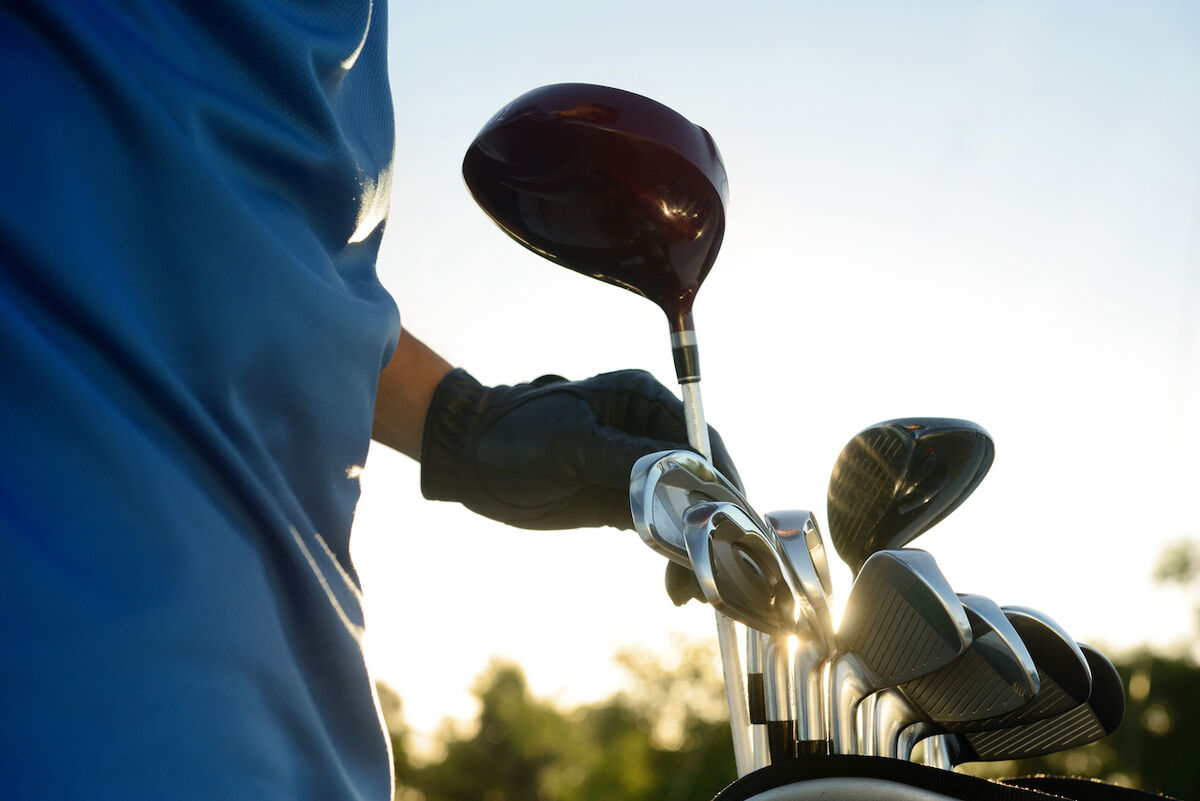
- DESCRIPTION Golfer pulling driver out of club bag
- SOURCE woraput/E+
- PERMISSION Getty Images License
The average distance golfers hit each club varies widely. A PGA Tour player hits a 7-iron between 172-215 yards. Meanwhile, a short-hitting amateur male golfer averages 120 yards with the same club.
Average Golf Club Distance Chart
Here's how far mid-handicap male golfers can expect to hit each club. Of course, specific distances for each individual player will vary based on several factors, which we'll detail shortly.
According to the USGA, golf’s governing body in the United States, the average male amateur golfer hits driver 217 yards , as recently as 2019. That same year, the PGA Tour average driving distance was 293.9 yards. Men, women, seniors, juniors, professionals, amateurs and beginners all hit their clubs different distances. The following golf club distance charts break down the average distances of golfers at many different levels of the game.
Key Factors to Achieve Distance
The total distance achieved by a golf club is based on several factors, including swing speed, the club’s loft, the carry distance achieved (Note: The carry distance is the yardage from the point of impact to the point of landing.), and even the weather.
Swing Speed
The faster your swing speed, the greater the distance. According to TrackMan , the average PGA Tour player has a driver club speed of 113 MPH, resulting in a 275 yard carry. Meanwhile, LPGA Tour players average 94 MPH with driver, and carry the ball 218 yards.
Since we know that amateur male golfers hit driver an average of 217 yards, we can infer that average male golfers and LPGA Tour players have similar swing speeds, making the LPGA Tour average distances with each club a good benchmark for average amateur male golfers.
Each club face has a unique loft. For example, a driver is designed for distance and usually has only 8-13 degrees of loft. In comparison, a pitching wedge is designed to get airborne, with 41-46 degrees of loft .

How to Accurately Measure How Far You Hit Your Clubs
According to thegolfmentor.com , distances achieved by short, mid and long hitters can vary by as much as 50% depending on the club and the gender (see actual average distance ranges below). Men tend to have faster swing speeds and hit the ball farther. However, many women are long hitters, with some LPGA pros hitting the ball as far, or farther, than men.
Distance can be greatly affected by the weather conditions. Hitting a ball into a strong wind will greatly influence distance, and a dry golf course will give you more roll, and therefore more distance, than a soggy course.
Average Distances for Men
Average distances for senior tour players.

The 10 Best Drivers for Senior Golfers in 2023 for Huge Distance
Average Distances for PGA Tour Players
Average distances for women.
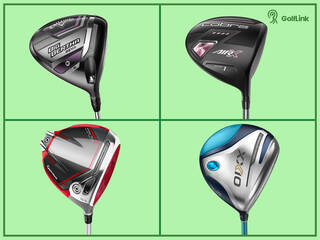
The 9 Best Drivers for Women of 2023
Average Distances for LPGA Tour Players
Tip: chart your distances for all your clubs.
Keep track of your average golf stats and scores with GolfLink's personalized game tracker. Sign up for free and create yours now!
Go to the driving range and hit ten golf balls with each club. Keep track of the ten distances you achieve with each club. Repeat the charting monthly, or more frequently if you are actively working on your swing.
The distance achieved by a specific golf club will vary from player to player and from day to day based on the conditions. Tour distance information was compiled from stats on pgatour.com, lpga.com, TrackMan.com and golfwrx.com.

Golf Club Distance Charts By Age, Gender And Skill Level
Last Updated on January 9, 2024 by Matt Greene
How far should you hit the ball?
How do you compare to others?
It's always good to know that age, gender, and skillset are the biggest differentiators so you don't make unrealistic comparisons.
I did so much research on this article to bring you the most up to date information to help you quickly skim the tables and charts about golf distance.
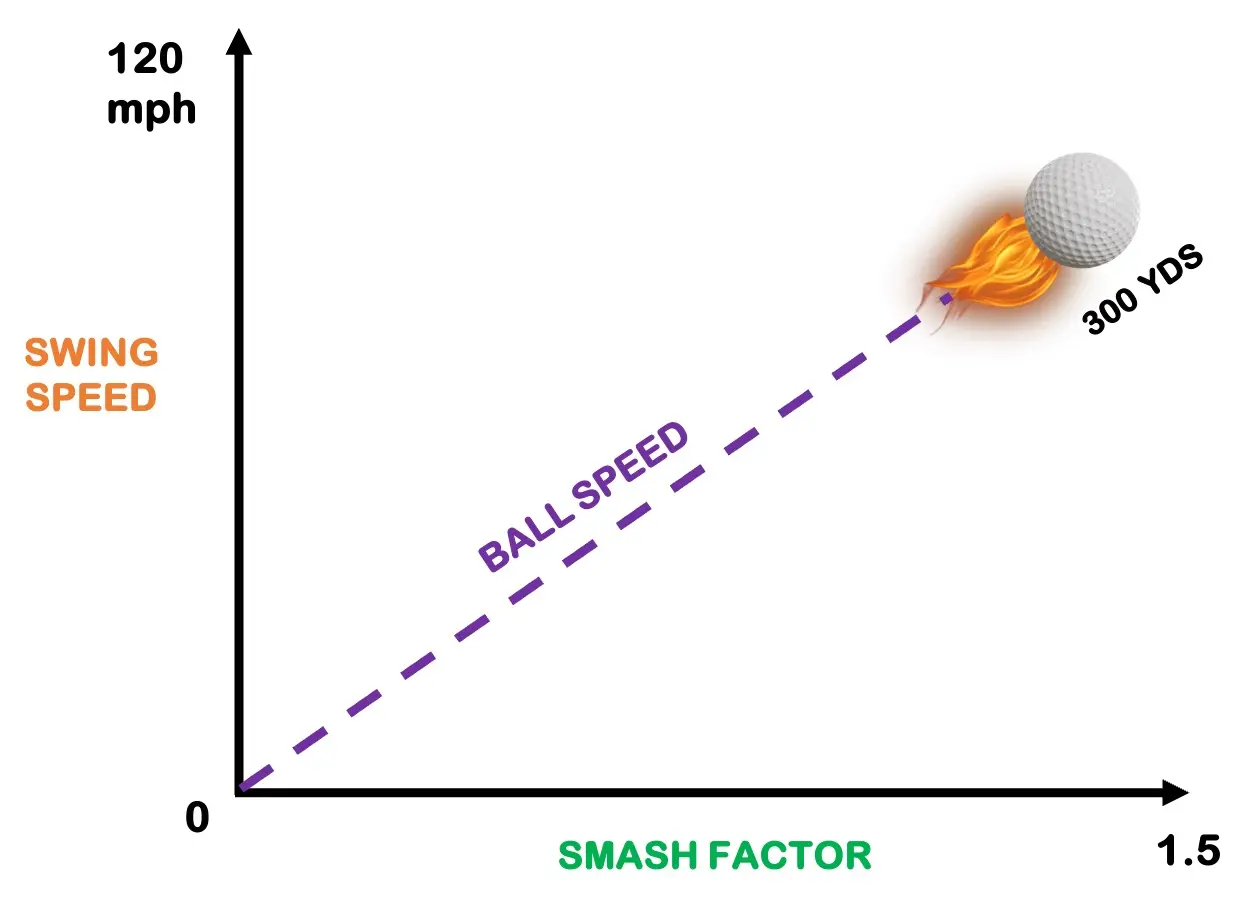
My golf distance charts show the key elements that influence how far you can hit each golf club:
- Swing speed
- Smash factor
- Quality and optimization of equipment
These factors are all heavily influenced by your physiology, skill, age and strength or flexibility levels. Very often, you can optimize each area, with some training or coaching or both.
Golf Club Distance Chart by Swing Speed
Swing speed is a major determining factor the golf club distances. It is not the only factor but if 100 people strike the ball the same, the fastest swings will carry the ball further.
- Most golfers are around 90 mph driver swing speed.
- The average swing speed on the PGA Tour is around 114 mph.
- 150 mph is the top range and only long drive competitors will be swinging toward this range.
NOTE: The swing speed at the top of each column is driver swing speed. We use this as a general gauge to estimate the distance of each club thereafter.
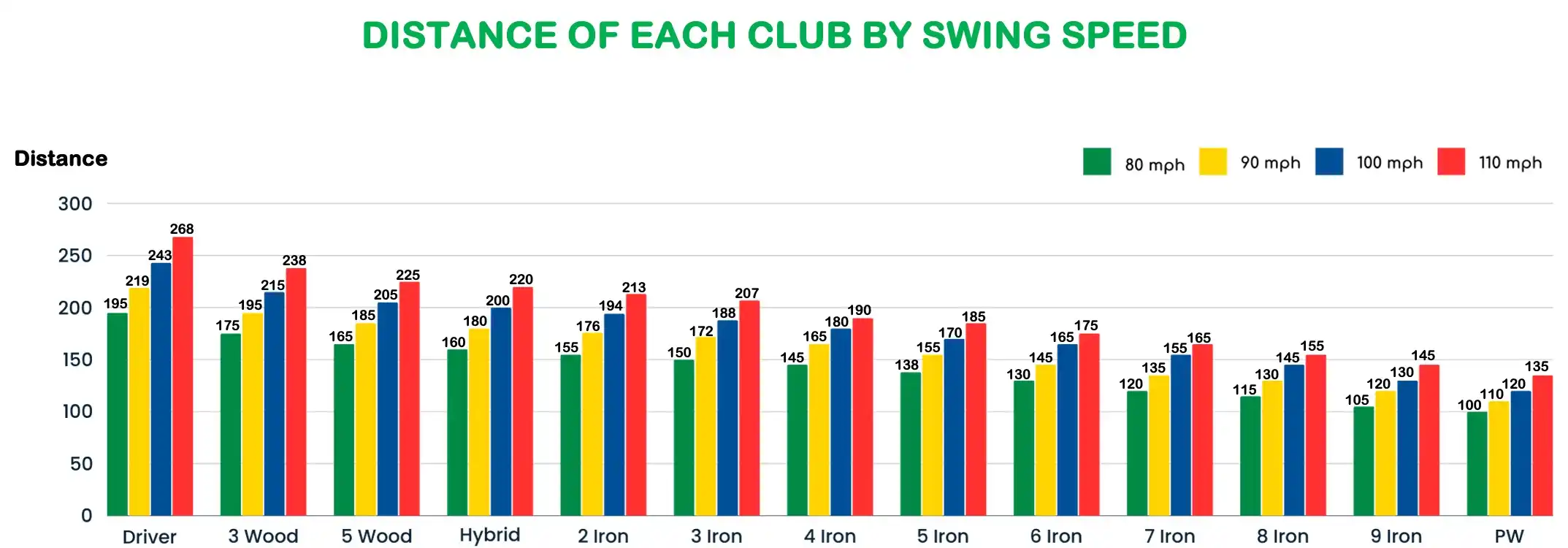
How do I swing the club faster?
You've compared yourself to the numbers in the chart but you want to hit it longer. Almost everyone does and there are 3 ways to swing the club faster:
- Get lessons on proper mechanics with a professional swing coach. They will utilize all your physiological elements and limitations to the maximum, as well as help you hit the ball in the center of the club face. You can add as much as 10 mph to your driver swing speed with correct technique.
- Get stronger and more mobile in the gym. Strength training plus mobility work with a trainer will increase your swing speed guaranteed. You will have a wider range of motion in your muscles and your strength will 100% translate into more speed. You can add 10-20mph to your swing depending on how advanced your strength and mobility currently is.
- Get lighter golf equipment fitted to your swing. Lighter shafts can help increase your swing speed 2-5 mph.
These are the only ways to improve swing speed but the MOST important factor is the coaching and practice so that you can HIT THE SWEET SPOT of the golf club.
The center strike means you send as much energy into the ball as possible and we measure how well you hit the ball using the Smash Factor.
What is Smash Factor ?
Smash Factor is ball speed divided by club speed.
For example: 150 mph ball speed / 100 mph swing speed = 1.50 Smash Factor
The number calculated gives a ratio to show how much energy is moved from the club head to the golf ball at impact.
Low Smash Factor numbers mean less energy is transferred, while higher Smash Factor numbers mean you send more energy from your golf club into the golf ball.
The optimum Smash Factor number for excellent ball striking with the driver is 1.50 Smash Factor.
Ideal Smash Factor for every club
The PGA Tour golfers are the best in the world so we can use their averages to assume the best smash factors in the world. If you can attain these smash factor numbers as stated by Trackman , you are striking the ball as good as you possibly can.
Note how the smash factor decreases as the loft increases.
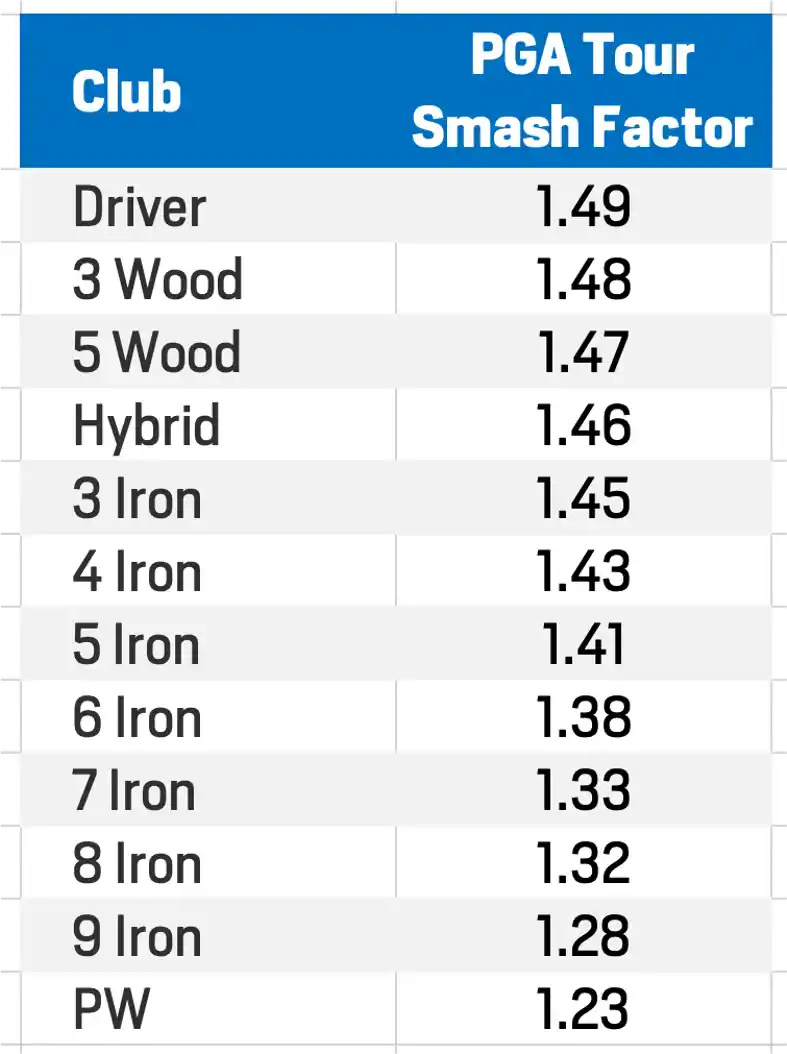
Skill level affects smash factor
Distance is affected by the swing speed but MAINLY the quality of the strike related to that swing speed.
In other words, how close to the center of the club face you hit the ball will determine how your swing speed power is transferred into the golf ball.
If you employ a swing coach, they will assist you in hitting the ball in the middle of the face, or closer to the middle.
That will take your existing swing speed and optimize it by being more efficient with where you hit the ball on the club.
The measurement we use for the quality of your strike is called Smash Factor.
Equipment affects swing speed and smash factor
The pros on tour have optimized equipment to their specific technique and skill level as well as body shape and strength.
The same swing speed in a PGA Tour pro will send the ball much further than an amateur golfer of higher handicap who has a similar swing speed.
The PGA Tour players technique is perfect so if you and a Tour pro hit the ball the same, the pro would still hit the ball further because their equipment has been customized to their exact swing.
A fitting can help to optimize your strength and swing for more distance.
Average Golf Club Distance For Male Golfers By Skill Level
From 'Good Golfer' onward, the 2 iron down to 5 iron should improve as confidence and technique improve, thus bringing more swing speed.
Beginner Golfer: New to the game - first 6-12 months.
Average Golfer: 15-24 handicap .
Good Golfer: 6-14 handicap.
Excellent Golfer: Below 6 handicap.
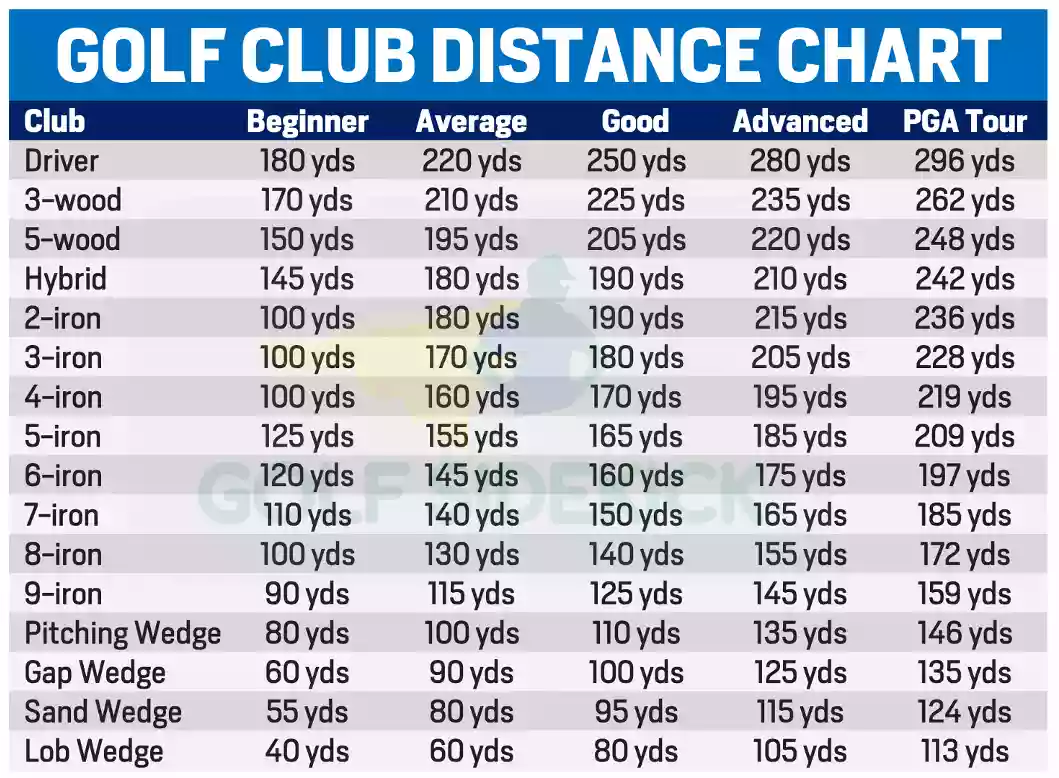
Swing speed charts by age and gender
Swing speed is a vital factor in determining the distance you hit the ball.
The swing speed, with a strike near the middle of the club face makes the ball go further.
A poor strike with high swing speed will go less distance.
A pro golfer swinging at the same speed as an amateur gets wildly different distance numbers because they hit the ball in the center of the face often.
Therefore, if you want to improve your distance with the same swing speed, you can work on improving your strike closer to the middle of the face.
Average swing speed by age and gender chart
In this chart we show the 50th percentile driver swing speed for each gender and age range according to the research done by TPI .
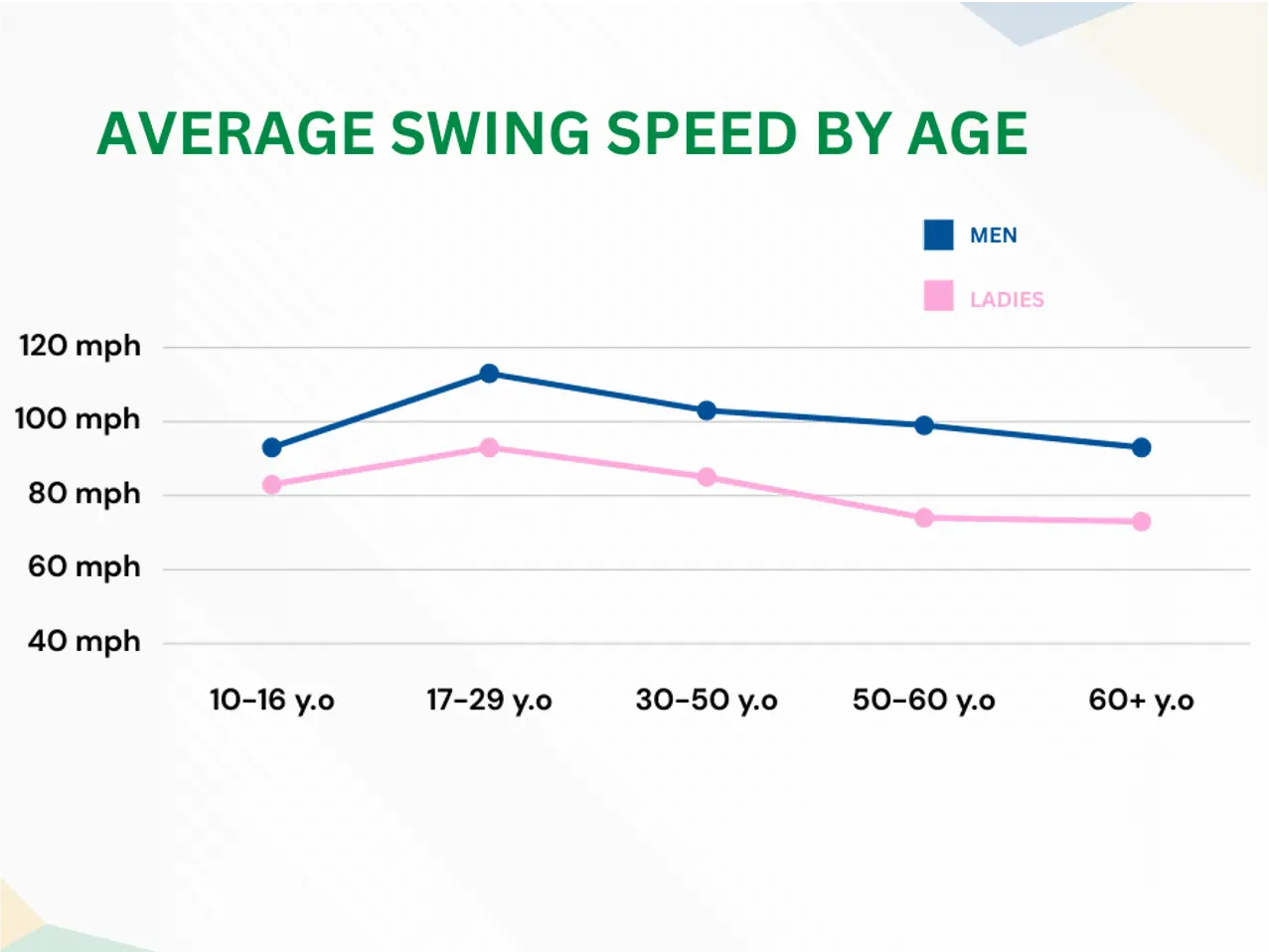
Driver Swing Speed Chart by Golf Skill Level
Confidence and skill make a big difference when hitting the driver efficiently and out the sweet spot.
Beginners with a driver will be more tentative and have less effective mechanics.
Mid handicappers will be more adept at the driver because of experience or lessons.
Advanced golfers swing with confidence from hitting a lot of golf balls and taking lessons with a pro.
PGA Tour golfers have optimized every aspect of the game with the driver and are the very tip of the spear.
Is a 250 yard drive good?
Yes it is very good. According to Arccos and Shotscope , between 15% and 31% of golfers hit 250 yards or more.
Here is a video of me breaking it down.
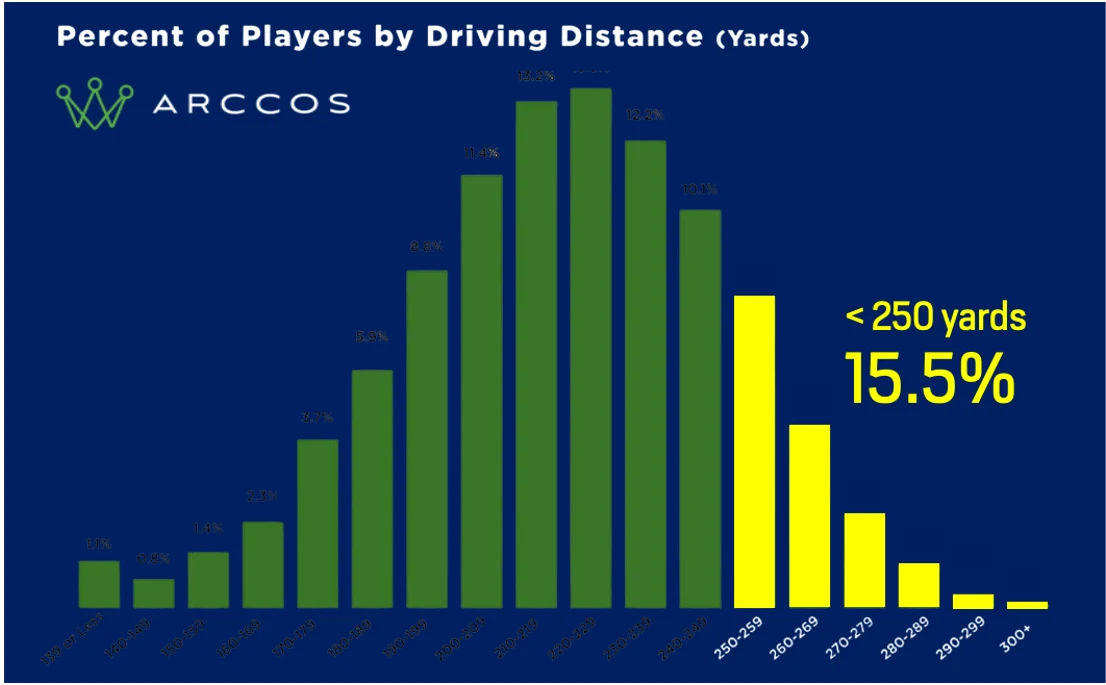
Ball Speed To Club Head Speed Chart for Driver
The ball speed off the driver face is dependent on the strike.
If your strike or Smash Factor is good, you will hit the ball further with your swing speed than the same speed with a bad strike.
Below, we take the club head speed and use a Smash Factor of around 1.42 which is 0.08 away from a perfect strike.
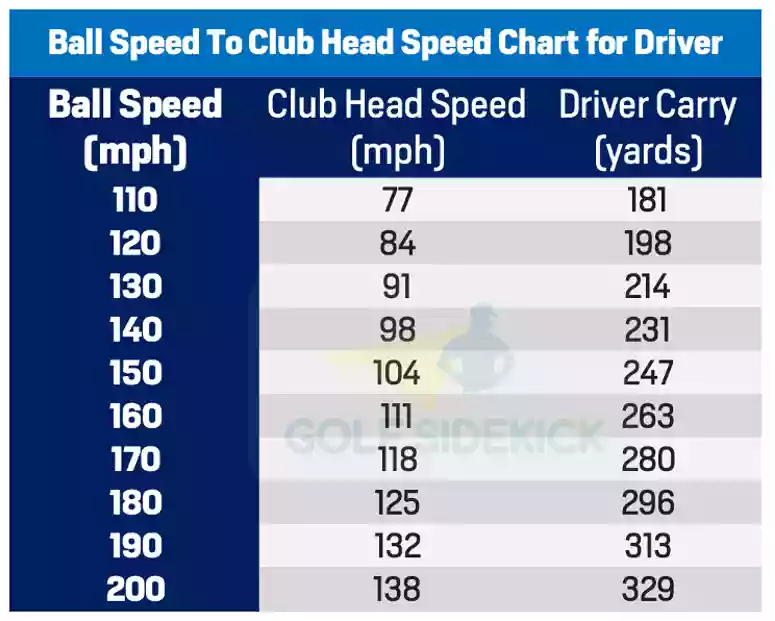
What swing speed hits 250 yard drives?
A swing speed of around 105 mph with the driver, and ball speed of around 150 mph will produce a 250 yard drive.
Ball Speed To Club Head Speed for 7 iron
A 7 iron optimal smash factor is 1.33. That is the PGA Tour average. Remember for the driver it is 1.50
The ball speed off the 7 iron is determined by the swing speed and smash factor.
As the clubs get shorter, the ideal smash factor actually changes.
What distance will you get from a 7 iron at every speed of swing?
What swing speed hits the 7 iron 150 yards?
A swing speed of around 76 mph with the 7 iron, ball speed of around 105 mph and dynamic loft of 21° will produce a 150 yard carry shot.
Golf Club Distance Charts Other Important Factors
Every club has a different loft and more loft goes less distance, while less loft goes longer distance in combination with longer golf shafts.
Driver usually goes furthest while the lob wedge around 60 degrees goes the shortest.
The golf clubs of today go a lot further since the manufacturers started creating cavity back golf clubs in combination with lower lofts for the same clubs.
Every club is between 2 and 5 degrees lower in loft in the current day, which automatically increases distance by up to 15 yards per iron compared to prior times. Driver lofts cannot get much lower as people will not be able to hit them. In order to hit a driver with a loft below 9 degrees, your swing speed needs to be incredibly fast.
An important factor to note for slower swing speeds, is that a higher lofted fairway wood or higher lofted driver can actually GAIN you distance because low lofted clubs are harder to launch at slower swings. Most golfers should be playing fairway woods with a loft that does not go below 16 or 17 degrees .
The club heads are bigger for all golf clubs in modern times with much larger sweet spots. With the addition of lighter shafts in both the irons and the woods, the ball speeds and swing speeds are higher as well. Check out our article on the flex of shafts in the current game.
Golf Club Distance Charts of PGA Tour Golfers
Why are modern golfers longer than prior generations, physical fitness.
Most modern pros are in the gym multiple times per week and in the physio offices often. In prior generations during the Arnold Palmer and Jack Nicklaus days, the pros were regular people who even used to enjoy a smoke and a drink on the course.
Bryson Dechambeau is an example of someone who bulked up in order to hit it further and it made a big difference. The side effects of that can be disputed as he has slimmed down again.
Tiger Woods was one of the first modern day pros to begin working in the gym. His huge transformation to a big, strong guy inspired a whole new generation of golfers and now most up and coming pros are hitting the ball longer than even this generation of pros.

Club advancements
Lofts have changed and the lower lofts in irons will change how far the ball appears to go with the same 'number' iron.
A 7 iron from the 80s may have had 40° of loft while a current 7 iron can have as low as 28° of loft. That 12 degree difference makes a 20-30 yard difference in distance.
The other important factor especially with the woods and drivers, is the materials of the clubs. The drivers now are lightweight titanium and carbon, with graphite shafts, optimized for huge distance.
That alone makes an astonishing difference when we compare to the old persimmon wooden clubs and heavy steel shafts.
The golf ball changed a lot with the release of the Pro V1. Golf balls just went further than ever before.
They spin less, they go straighter and they have advanced to a point that the ruling authorities of golf want to make them go shorter to preserve the golf courses.
If the pros hit the ball too long, they need to extend the golf courses, and there is a lkmited amount fo land available.
The balata golf ball is significantly shorter than the current urethane covered solid core golf balls they use today on the Tour.
You can compare how you shape up against the average golfer, the senior golfer, the pro golfer and the advanced golfer.
The key though is to understand your own game and your distances so you can more effectively plan your game and piece together a good golf score. When you fully understand and accept your distances that you hit the golf ball, you will score better.
For the pros and the advanced players, the distance they hit each club is not a matter of ego. It's a matter of 'which club gets the job done?' and they use that.
You can too, whichever distance you hit it.

Golf Club Distance Chart: By Skill Level, Age & Gender
- Last updated on April 12, 2021
I reviewed data from Trackman, Flightscope, Arccos, and more. I mapped them to different skill levels, ages & genders . In the end, I have also included the stock distances of famous pros!
There is a lot of information about how far you should hit your clubs, but they often lack completeness and background information. I have set to change that and will also cover what influences distance and how to improve it.
Table of Contents
Golf Club Distance Chart for Men By Skill Level
This chart shows you the average distances per skill level for male golfers. Where are you on this chart?
Golf Club Distance Chart for Woman By Skill Level
This chart shows you the average distances per skill level for female golfers.
Golf Club Distance Chart for Senior Golfers
This chart shows you the average distances per skill level for senior golfers .
Golf Club Distance Chart for PGA Tour Players
Here is how far male PGA Tour professionals hit their clubs in average.
Golf Club Distance Chart for LPGA Tour Players
This chart shows you the average distances for LPGA Tour Players.
Golf Club Distance Chart By Swing Speed
What impact does swing speed have on distance? In perfect conditions, see the table below. Keep in mind that the smash factor plays a major role when it comes to distance.
Ball Speed to Distance Conversion Chart
Driver swing speed chart by skill level.
How fast should you swing your Clubs? Kyle Berkshire’s (World long drive champion) fastest recorded swing speed was 155 mph!
Key Factors for Distance
Each club has a unique loft. Typically, higher lofts will translate into higher ball-flights. For example, drivers are built for distance , hence they have a low angle of loft. Lob wedges on the other hand are designed to propel the ball into the air and present a steep angle of descent. That way, the ball will stop closer to the point of impact.
Your distances are greatly affected by the weather conditions. Hitting a ball into the wind might balloon it into the air, taking away length. In contrary to playing in high altitudes, players usually experience increased distances. See Rory’s distances WGC-Mexico Championship in Mexico .
Swing Speed & Smash Factor
Logically, the faster your swing speed, the greater your distance. But in addition, the quality of strike plays a huge role to determine how far you hit the ball .
Smash Factor is ball speed divided by club speed. Smash Factor relates to the amount of energy transferred from the club head to the golf ball . The higher the smash factor the better the energy transfer. A golfer would hope to achieve a smash factor near 1.50 on driver shots.
Famous Pros
Tiger woods.
PGA Tour Victories: 82
Phil Mickelson
PGA Tour Victories: 44
Jack Nicklaus
PGA Tour Victories: 73
Rory Mcllroy
PGA Tour Victories: 18
Note: Measured at 7,600 feet above sea level, WGC-Mexico Championship at the Club de Golf Chapultepec Club, Mexico.
Bryson DeChambeau
PGA Tour Victories: 8
Dustin Johnson
PGA Tour Victories: 16
Know your distances
Looking at the charts can be intimidating. On the other hand, it can also lower your expectations! More important than how far you hit the ball is to know your own distances.
Go to the range and map out your 50%-100% distances with every club. In the end, nobody cares if you placed the ball 3 feet from the hole with a 6 iron or a 9 iron.
What to do next
Look at our favorite swing tips to improve your game! More distance off the tee is an easy way to lower your scores !
Francesco Diomaiuta
Best glow in the dark golf balls in 2024, callaway chrome soft vs. supersoft – 2024 pga pro review, best driving irons in 2024 – straighter and further off the tee, best golf balls for mid-handicappers, best golf irons for mid handicapper in 2024 – expert review, best japanese golf driver 2024 – pga pro review, save 30% on your next order.
We have partnered with GlobalGolf.com to offer you the best deals for Golf Clubs and accessories! Click on the button below the view their offers.
Automated page speed optimizations for fast site performance

By Coach Erik Schjolberg – Jan 7, 2024
*Read our review guidelines .
How many times have you heard the 30 something weekend warrior say they hit their drives 300 yards? Better yet, how shocked were you when you first saw how far you actually hit it off the tee?
You’re not alone.
Key Takeaways
- The average male amateur drive distance is 217 yards
- Average distance on PGA tour is 293 yards
- 70% of amateur golfers average less than 250 yards off the tee
- Golfers 50 and younger average 238-220 yards off the tee
- Senior golfers average 211 yards with driver
- Consistent contact will improve distance just as much as speed
- Handicaps above 28 average 177 yards
- Single digit handicaps (5-9) average 231 yards off the tee
Most people are looking at their drives with rose colored glasses. The average driver distance for amatuers might shock a lot of you. Through recent studies, it is found that the average drive distance for male amateurs is just 217 yards!
For perspective, would it surprise you that the average drive distance on the PGA tour is less than 300 yards? On tour, the average distance off the tee is 293 yards.
Here I will break down the subsections that create that yardage of 217, to better explain how the number is so much lower than a lot of players think they hit it.
Average Drive Distance for Amatuer Golfers
Amateur golfers of all ages and skill levels average a driving distance of 217 yards. Less than you thought? Probably. But that is why amateurs are amateurs, and touching 300 yards off the tee is such a feat.
Two point list data collection products on the market are Arccos and Shot Scope. Their datasets should offer different insights to the driver distance game. If you are using one of these tools, you must be a serious golfer, and thus have more serious drives.
Arccos Average Driver Distance Report
Arccos Swing Caddie is a popular distance tracking system. It involves inserts at the butt of the club, and communicates with your smartphone to track the distances of each hit.
Each year Arccos releases a distance report. It compiles data of over 516,000,000 recorded shots! That is an incredible data set! For the driver section, Arccos only takes data from players who hit driver at least 60 times in the calendar year.
With that requirement, Arccos found that out of 29,466,594 shots with driver, the average distance was 219.4 yards. Slightly longer than the 217 average.
This is because a player using Arccos is a slightly more committed golfer than someone who only plays a few times a year, and has no interest in such data collection.
Shot Scope Driver Distance Chart
Shot Scope is another popular distance tracking product that operates similar to Arccos. Inserts in the butt of the grip, app on the phone, and Shot Scope also has a watch.
Shot Scope pooled all of their logged distances off the tee, and found that their users average 225 yards off the tee. This is nearly 10 yards further than the total average of 217.
This is also because tech like Shot Scope tends to attract lower handicappers and longer hitters. Shot Scope also found that 70% of amateurs average less than 250 yards off the tee.
This offers incredible insight into the distance game. Shot Scope has also found that driver averages vary between handicap and age. Furthermore, they found that as age increases, distance decreases, and it causes the handicap to go up.
Average Golf Driving Distance by Age
As you can imagine, age has a major impact on distance off the tee. Throughout the entire bag really. This is because distance is all about swing speed.
As you get older, your flexibility and strength decrease, and those are speed killers. Golfers from 20-30 years old average 238 yards off the tee. That is 20 yards further than the overall average.
From 30-40 years old, the average driving distance drops to 231. Still above the average, but trending downward. Even at ages 40-50 years old, the average driving distance is still above the 217 average at 220 yards.
So if those age groups are above the average, 20-50 years old, how is it possible the average is just 217 yards? This is because a large portion of the golf community is over the age of 50.
For senior golf , ages 50-60, the average driving distance drops to 211 yards, and below 200 when you get above 60 at 196 yards. With 26% of golfers above the age of 60, their numbers tend to drive the overall average.
Driver Distance by Swing Speed
It’s a pretty simple formula; Speed = Distance. There are nuances, of course, like launch angle, spin, ball quality, elevation, wind, etc. that can affect driving distance, but the fact remains.
The faster you swing, the farther it will go. Things like strength, flexibility, and lag can increase speed, and not having those things can decrease speed.
It has been found that swing speed not only affects distance, but also handicap. It might be surprising, but it’s pretty simple. Swing faster, hit it further, and you are closer to the green.
Player A hitting a short iron approach shot will have more accurate results than Player B needing a mid to long iron on the same hole. They don’t call short irons “scoring clubs” for the heck of it!
The average driver distance for someone with a 60mph swing speed is just 157 yards. If you struggle with this, check out our recommendation for the best driver for slow swing speed .
Conversely, the Tour Pro swing speed average of 113mph garners 293 yards.
The average male amateur swing speed with driver is 93mph. At that swing speed, with consistent contact, the total driving distance is around 246 yards. So how is the average for amateurs only 217 yards?
Again, the answer is simple, consistent contact. An amateur tends to make strikes all over the face, and rarely the center. Consistent center contact can add nearly 30 more yards of distance!
So yes, speed equals distance, but there is something to be said about dropping the DeChambeau speed training, and working on consistent contact!
What are the Average Golf Drive Distance Differences Between Men and Women?
The average driving distance between men and women is mostly because of size and strength, but did you also know that the average men’s driver is 10.5°, while the average women’s driver is 12°?
That increase in loft certainly has an impact on driving distance. The higher loft does however make it more forgiving and easier to hit in the air. The difference in distance between men and women is fairly significant, but as stated before, skill plays a huge role, and narrows the gap.
The average driving distance for men is 217 yards, and the average driving distance for a female golfer is 148 yards. A difference of 69 yards. However, as the handicap lowers, as does the difference between men and women.
Average Driving Distance by Handicap
- Consistent contact
- Solid swing mechanics
Sure, two players with the same level of skill, the one who swings faster hits it farther, but the gap isn’t nearly as great as two players 10 handicap points apart.
If you’re a new golfer, first off, check out beginner golf tips to get started; or you carry a handicap above 28, meaning you shoot 100+ every round – the average driver distance is 177 yards. This is mainly because the ball rarely finds the center of the face, and a swing path that causes a slice/hook.
With some practice and hard work, possibly getting a high handicap driver , and lowering the handicap into the 20s, the average driver distance gets close to breaking 200 yards at 195. Again, the main culprit is consistent contact and swing path.
It isn’t until handicaps are in the teens before 200 yards is broken off the tee. Handicappers 10-19 average 215 yards with the big stick.
Single digit handicap players (5-9) average 231 yards off the tee, which can be a surprising figure, but a 5-9 handicap is a lot farther from scratch than you think. That being said, reaching single digit handicap is quite the accomplishment, and takes a lot of hard work.
A sub 5 handicap player averages 250 yards off the tee. That is a 73 yard difference compared to a high handicap player. That puts a 9 iron in the hands of a low handicapper compared to a 3 iron/hybrid left for a higher handicap player.
The lower handicap player will also likely be in the short grass versus the higher handicapper likely in the rough or worse. They say “drive for show and putt for dough” but looking at it this way, you need the show to get the dough!
Average PGA Tour Drive Distance vs LPGA Tour
At the Tour level, PGA pros average 293 yards off the tee. LPGA pros average 256 yards with the driver. That is only a difference of 37 yards.
Yet another example that skill is just as important as speed. The difference between PGA and LPGA driver distance is nearly half that of total driver average for all men and women.
The longest player on the LPGA Tour, Emily Kristine Pedersen, averages a whopping 281 years off the tee. That is 25 yards above the average.
On the PGA Tour, the longest driver average crown belongs to Cameron Champ. He averages 322 yards from the tee box! Average! That’s nearly 30 yards farther than the total average.
Golf Driving Distance Benefits
Why hit the ball farther? Is it fun? Sure. Impress your playing partners? Absolutely. The real answer is, lower scores.
If you hit the ball farther, and more accurately, you will have shorter clubs into the green, and that increases your chance at birdie.
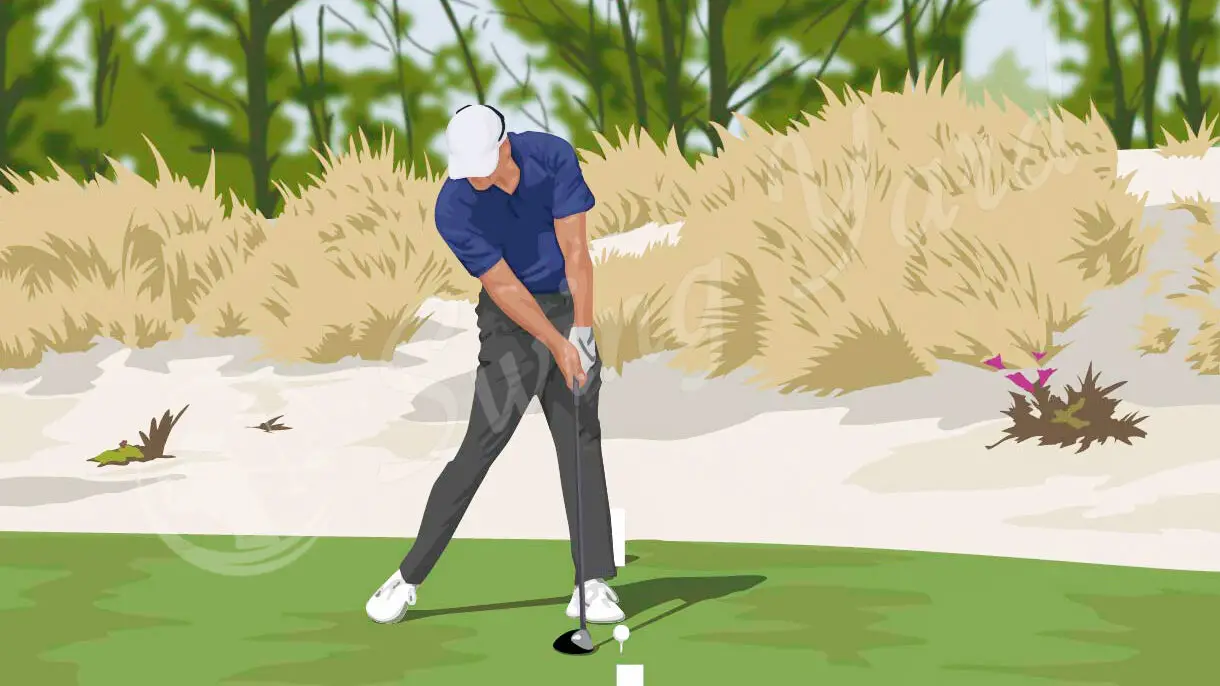
If you can hit the ball farther, par 5s become real scoring opportunities. On the PGA tour, the average score on par 5s is significantly lower than par 3s and 4s. This is because a long drive gives you a chance to reach the green in two, and a look at eagle or two putt birdie.
Golf is all about scoring, and scoring as low as possible. Longer drives usher in those scoring opportunities, and give you options at every hole.
Average Driver Carry Distance vs Total Distance
When talking about averages off the tee, the total distance number is the number that is used. The average total distance for male golfers is 217 yards. The average carry distance is 197.
That means the average roll out is 20 yards. This is important to keep in mind. For example, you are on the tee and see there is a hazard 200 yards from the tee box.
One may think “oh I hit the ball 217 yards, I don’t need to worry about that!” You certainly do! Not knowing your carry distance will get you a water hazard penalty , and cost you strokes.
How Far Should I Hit My Driver?
The fundamentals of driver distance.
Hitting a driver, and how far it goes, is affected by many variables. Attack angle, swing speed, swing arc, optimum driver launch angle , and impact position all can increase or decrease your distance.
Unlike iron shots, the driver should make contact with the ball on an upward angle. Hitting the ball at a downward angle will increase backspin, and zap distance worse than anything.
Optimal Driving Distances
The optimal driving distance varies between age group and skill level. A younger player or lower handicap should hit the ball further, making optimal driving distance 230 yards and up.
As age increases or skill level decreases, you need to manage expectations off the tee. Any drive over 200 yards should be considered a win. Finding the short grass even more so!
Tips to Increase Driving Distance
You need to learn how to hit a driver the right way . Here are a few tips:
1. Find the Sweet Spot (improve your impact location)
Center contact is going to get you the best results. Drivers are designed to pack the most punch at the center of the face. The “sweet spot” is not a myth. Improving your impact consistency will help you gain distance more than a few miles an hour swing speed!
2. Hit Up on the Golf Ball (tee height and attack angle)
Angle of attack reduces spin, increases drive height, and greatly improves distance. Keeping your trail shoulder down, and “hit up” as a swing thought will do wonders for your club head position at impact.
Finding the optimal tee height will help get to the proper attack angle, and create distance. A higher tee height should help reduce backspin, which also improves distance. Lower tee height will effectively create the opposite effect.
3. Increase Club Speed
This one is an easy one. The faster you swing, the farther it will go, right? Sure, but without a proper swing path, more speed could accentuate a swing flaw.
Killer slice? With 10mph more swing speed, that banana ball will just get worse. Although swing speed is important, as is a repeatable swing. That shouldn’t deter you from increasing your swing speeds though!
4. Know Your Data
Knowing your metrics is important throughout the game of golf, but arguably most important off the tee. Knowing your carry distance, total distance, spin rates, launch angle, and impact position can help you improve your game.
This will also help you track improvements in your game, or find where you are lacking. Having access to these metrics and data is more accessible now more than ever, and should be utilized whenever possible.
5. Use a Distance Golf Ball
Some balls are geared more towards control and spin around the greens, while others are designed more for getting the most distance down the fairway. Some are kind of in the middle. Check out our list of the best golf balls for distance if you’re looking to squeeze out some more yardage off the tee.
Final Thoughts
Unpacking all this information about driving distances is truly eye opening, and important to everyone’s game. It’s not just for the pros anymore!
It is very easy to overestimate your distance off the tee, and it doesn’t do you any favors. I think most of you will find peace in knowing the average distance off the tee is 217 yards.
You see the pros on TV hitting 5 iron that far, and assume there is no way you are that far behind. Although none of us think they can throw a fastball like Justin Verlander, or a football as far as Patrick Mahomes, so why would you be able to hit the ball as far as Rory?!
The common thread throughout this in depth look is that consistent contact is just as important as swing speed. Hitting up on the ball, finding center contact, and a stable face will get the ball going straight.
Until you get those fundamentals down, swing speed should be secondary. Hit up, consistent contact! The ball will do the rest!
How far does the average golfer drive the ball?
The average golfer drives the ball 217 yards on average. This is taking into account all ages and handicaps.
How far is a good drive in golf?
A good drive in golf is a loaded question. A lot of factors play into what makes a “good drive.” The short answer is over 200 yards and in the fairway. That will position you for a chance at par.
How far does Tiger Woods drive?
Tiger Woods drive distance average has changed over the years. Peaking in 2018 at 303.8 yards. Seemingly, his age and injuries haven’t slowed him down off the tee. Tiger averaged 301.1 yards off the tee in 2021-2022 in two events.
What is Bryson DeChambeau’s average drive?
Bryson DeChambeau’s average drive distance has been a scientific adventure to say the least! He has transformed his swing and body to maximize swing speed.
Bryson was averaging 299-302 yards off the tee before he started his transformation. The 2019-2020 season was the debut of the Bryson Project. That year he averaged 322 yards off the tee! More than 25 yards farther than the PGA average!
Can A New Driver Increase Distance?
A new driver can certainly increase distance. Technology advancements can help increase distance without changing your swing. A good rule of thumb is 1-2-3.
If your driver is a year old, you will likely not see much change. Two years old will provide a mixed bag of results. If your driver is three years old or more, then you should see some significant gains due to technology advancements if you decide to get a new 2024 driver .
Why Does My Driver Not Go Far?
Most of us have asked the question; Why won’t my driver go far? There could be a few reasons, or one big problem. The biggest issue is a developed swing flaw, or you may be popping up driver .
The issue could also be your driver losing its POP. High levels of repeated stress to a driver’s face can cause microfractures. These stress fractures can decrease the performance of the face.
However, club makers spend a lot of time, and money, to make faces that handle a lot of stress. Every driver is different though. If you notice distance losses, maybe it’s time to shop for a new driver.
Does A Longer Driver Shaft Length Add More Distance?
A longer shaft can add more distance off the tee, but it comes at a price. The general rule is every extra inch will add 5 to 10 more yards of distance. Check out our standard driver shaft length recommendations .
The extra length has an equal and opposite effect on accuracy, especially with amateur golfers. Amateurs will find a longer driver harder to bring square at impact, which will put the ball all over the course. Keep your accuracy intact by choking up on your driver .
Will I lose driving distance during the winter months?
Yes, you’re going to lose a little driving distance when it’s cold out. The ball won’t compress as much, the air is typically more dense, among other factors changing the way we play golf during the winter time .
About the Author
By Coach Erik Schjolberg – Last Updated Jan 7, 2024
Expertise: Golf Instruction Golf Equipment Testing Golf Practice Programs Online Golf Instruction
Coach Erik actively coaches several PGA Tour Professionals . He’s the head golf instructor and writer here at Swing Yard, was voted the “#1 Golf Coach in Scottsdale, Arizona”, and has been coaching for over 20+ years. Erik also owns and operates his own online golf school, EJS Golf Academy . His other credentials include: Active PGA Coaches Membership, Titleist TPI Level 1 and 2, Trackman Certified Level 1, Dr. Kwon’s Biomechanics Level I and II, Scott Cowx Certified Level I Advanced, BodiTrack and V1 Sports Pressure Mat Certified, Titleist Club Fitting and Ball Fitting Certified, PGA Hope, and Sportsbox AI. Check out Erik’s full bio and certifications for more info.
Leave a Comment Cancel reply
Save my name, email, and website in this browser for the next time I comment.

Your Golf Travel Inspiration
Driver Distance – You Might Be Surprised!
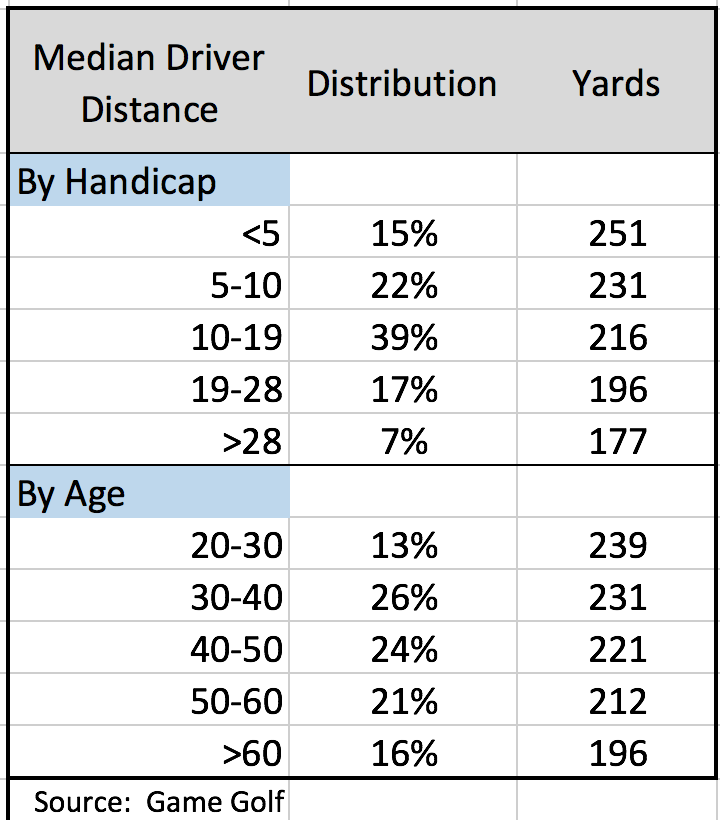
Because you swing slower as you age, your average distance declines predictably. But the golf club doesn’t know your age. Assuming acceptable clubface contact, what matters most is swing speed. Better golfers have higher swing speeds. USGA data shows that thirty-one percent of US golfers have a single-digit index. According to Game Golf data, Thirty-seven percent of their users have single-digit handicaps. It appears that better players are more likely to use the Game Golf product and this data doesn’t accurately reflect the golfing population at large.
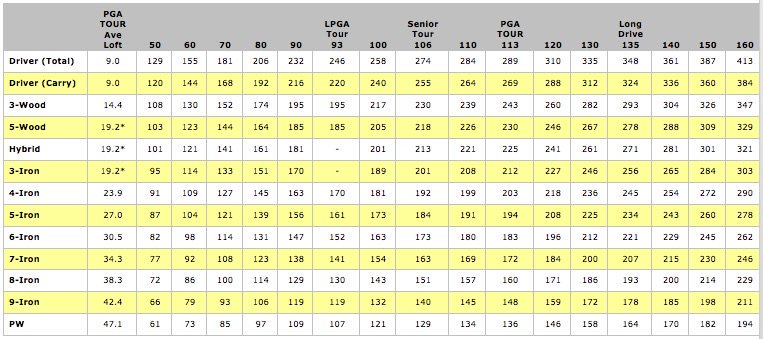
Distance is directly related to swing speed. Although the PGA Tour Pros swing between 110 and 120mph, you need not be that fast to score well. The average Senior Tour player swings a driver at 106mph and hits it 274 yards. But the average LPGA Tour Pro swings a driver at only 93 mph and hits it 246 yards. They hit a 130 yard 8-iron and a 170-yard 4-iron. If you can do that, then why can’t you shoot par or under par like the LPGA pros? Consistency, short game, and putting are the difference. Don’t spend a disproportionate amount of time on swing speed. Next time, play from the forward tees, and see how long you can go.
Share this with your golfing buddies and travel partners:
12 thoughts on “driver distance – you might be surprised”.
Just found this article about 2 years after last comment. I’m a 60 year old golfer that can get obsessed with data. I was fitted at TXG in Canada for a full bag. Download data for 50 driver swings. Avg club speed is 105mph, carry 249, total 270. Found some data that said PGA Tour players avg about 2.62 yards per mph club speed, so I’m about 5 yards short based on less efficiency. Avg PGA player avg 300 yards on 114.6 MPH club speed. So I figured out I’m 30 yards short of their avg, of which 5 yards is skill and 25 is strength. Motivated me to hit the weights and exercise to get stronger and faster. I wouldn’t exercise to extend my life, but sure as heck will to try and make the number go bigger on my PRGR launch monitor I just bought. I’m an odd man.
How can senior tour players hit drives over 325+.I was watching the senior golf today and the Guys were saying some of their drives were going well over 300 yards I think thats a bit much.
I thought it was very interesting seeing the actual distances or averages for somebody who swings a driver and a very constant 82 mph. I have been attempting to literally swing out of my shoes and get the driver to fly 230 yards. Every one of my drives are between 202 and 205 yards. Using the scale that you had published and bring my clubs perform in those distances I discovered my game improved dramatically. I am 66 years old I play 18 holes every other day. And I still walk. Long par fours of 390 yards to 400 I have resolved myself and I cannot reach them in regulation. So thank you for your information it is actually helped my game. Wm Holt
That chart does not make any sense, unless the swing speed is in mph, and the distance in meters or something like that. I carry 163 yards with my 8 iron, my swing speed is 89.5 mph, ball speed 120.8, smash factor 1.35, all figures are average measured with a radar. 9 iron is 155, 7 iron 175, 6 iron 186, all with similar swing speeds and smash factor.
According to the chart I should have a SS of 113mph, which I cannot reach even with my driver…
2 things I think may contribute to the confusion. I went through similar thoughts and numbers myself. I think the main issues is that I think that the swing speed on the top row is based on driver speed, so on the 8 iron row, the distance isn’t with the mph listed up top as how fast you swing the 8, but rather how fast you swing your driver. Find your driver speed and that entire column should match up to your club distances. The 2nd factor might be what type clubs it’s based on. If it’s tour type forged irons as opposed to game improvement, stronger lifted cavity backs, then at the same awing speed distance irons are going to go a club farther. I know that’s kinda what you are getting at with smash factor.
The swing speed at the top of the chart is for the driver.
You may be playing with “strong” irons … my Calloway Maverik irons are 3 to 4 degrees stronger than standard … so I am hitting my 7 iron a normal 6 iron distance.
no way does a LPGA player improve 40 yards from a 8 iron to a 7 iron. Makes the entire article obsolete.
Not sure what you’re referring to. The LPGA column shows an improvement of 11 yards from 8 iron to 7 iron.
John – There was an error in the article. The 170 yards refers to a 4-iron, not a 7-iron. I have fixed this. Thanks for catching it.
1) Obsolete is the wrong word to use; and 2) not sure what you’re looking at, as the 7-iron is 11 yards further than the 8-iron. All of those measurements line up with every average LPGA stat I’ve ever seen.
The article compares the eight iron and the four iron. Read it again
Leave a Comment Cancel Reply
Your email address will not be published. Required fields are marked *
How Far Do PGA Tour Pros Hit The Ball?
Whether you like it or not, distance is always talked about. But how far do PGA Tour pros hit the ball? Let's find out
- Sign up to Golf Monthly Newsletter Newsletter
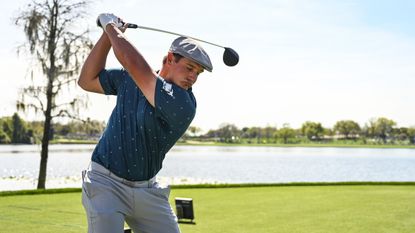
Distance is a hotly debated subject and not just in the clubhouse at your local municipal. So much so, earlier this year, the United States Golf Association (USGA) and R&A sent an official notice to equipment manufacturers, detailing new areas of interest in the distance debate.
The notice did not include any official changes to the Rules of Golf but it did give a glimpse into the future and just how they intend to stop the ever increasing trend of further drives and lengthening of golf courses.
As the general consensus is that PGA Tour pros hit the ball too far, do you know how far they actually hit it? Well, let's take a look.
The PGA Tour collates this information under the Driving Distance category. The average number of yards per measured drive is recorded on two holes per round. The PGA Tour accounts for possible variance, such as elevation and wind, and take care to counteract this effect in the chosen holes. The drives are measured at the point in which the ball come to rest regardless of whether it is in the fairway or not.
Cameron Champ leads the 2022 Driving Distance category with a whopping average of 326.1 yards. The American maintains a rather comfortable lead with Matt Wolff some 5.4 yards behind - averaging 320.7 yards off the tee.
The 5.4 yard difference between Champ and Wolff separates Wolff and Luke List; who is twelfth in the Driving Distance category - averaging 315.4.
The PGA Tour average driving distance is 298.4 yards; which is enough to rank 106th in the category. Notable players that fall beneath Tour average are Matt Fitzpatrick, who came agonisingly close to his first Major at the PGA Championship, Russell Henley, Billy Horschel, Abraham Ancer and Daniel Berger.
Get the Golf Monthly Newsletter
Subscribe to the Golf Monthly newsletter to stay up to date with all the latest tour news, equipment news, reviews, head-to-heads and buyer’s guides from our team of experienced experts.
What Is The Longest Drive Ever Hit On The PGA Tour?
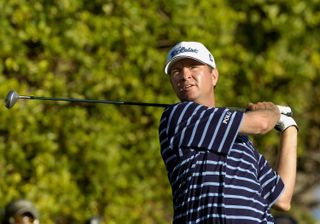
Unfortunately, this isn't as easy to answer as you might think.
The PGA Tour introduced ShotLink in a limited capacity in 2000. Since 2003, they have used the laser-based system to gain precise measurements on every hole - something which was not possible before.
Prior to 2003 and the expanded use of ShotLink, Tiger Woods hit a 498-yard drive on the 18th hole at the Plantation Course at Kapalua during the 2002 Mercedes Championship. Sadly for Woods, this is classed as an 'unofficial record.'
David Love III takes the spoils in the post-2003 era having driven one 476-yards on the exact same hole as Woods during the 2004 edition of the Mercedes Championship. Those familiar with the event will be aware of the cambering fairway that can be used to the players advantage.
Perhaps the most impressive drive recorded was by Jeff Sluman, who, at 5 foot 8 inches tall, put one out there 473-yards at the PGA West course during the 2003 Bob Hope Chrysler Classic. Pound for pound, that is an extremely long drive.
Driving Distance Analysis Through The Years
- The 2022 leading average driving distance is the longest in the last ten years
- The 2022 tour average driving distance is the longest in the last ten years
- The difference between the longest and tour average was the biggest in 2015 (28 yards)
- The difference between the longest and tour average was the second biggest in 2022 (so far - 27.7 yards)
- The average driving distance has increased 11.2 yards in the last ten years
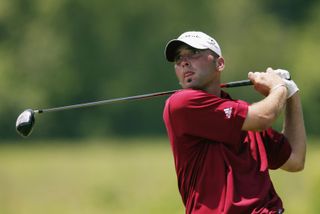
Driving Distance Leaders Through The Years
In 2003, Hank Kuehne averaged a staggering 321.4 yards off the tee. Only Bryson DeChambeau (2020 & 2021) has bettered that total across a full PGA Tour season.
James joined Golf Monthly having previously written for other digital outlets. He is obsessed with all areas of the game – from tournament golf, to history, equipment, technique and travel. He is also an avid collector of memorabilia; with items from the likes of Bobby Jones, Tiger Woods, Francis Ouimet, Arnold Palmer, Lee Trevino, Adam Scott and Ernie Els. As well as writing for Golf Monthly, James’ golfing highlight is fist bumping Phil Mickelson on his way to winning the Open Championship at Muirfield in 2013. James grew up on the east coast of England and is the third generation of his golfing family. He now resides in Leeds and is a member of Cobble Hall Golf Club with a handicap index of 1.7. His favourite films are The Legend of Bagger Vance and Tin Cup.

Nicknamed King of the Screen, Hongtaek Kim defeated Chonlatit Chuenboonngam in a playoff to win the GS Caltex Maekyung Open
By Matt Cradock Published 5 May 24
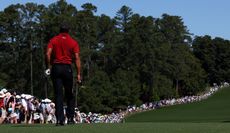
If you wanted to get hold of the famous red polo that Tiger dons, you would have had to be quick, as the first batch of the 'All Things Red' Collection sold out rapidly!
- Contact Future's experts
- Terms and conditions
- Privacy policy
- Accessibility statement
- Cookies policy
- Advertise with us
Golf Monthly is part of Future plc, an international media group and leading digital publisher. Visit our corporate site . © Future Publishing Limited Quay House, The Ambury, Bath BA1 1UA. All rights reserved. England and Wales company registration number 2008885.
Share a link to this question
This answer is live and will keep updating
a]:underline [&>a]:text-team-secondary"> Rory McIlroy had the longest average driving distance in 2022-23, at 326.3 yards.

- Who won the Open Championship in 2022-23?
- Who has hit the most holes in one all-time?
- Who has the best sand save percentage this season?
- See trending
Advertisement
Wells fargo championship 2024 odds, course history and picks to win, share this article.
The PGA Tour’s best players — minus world No. 1 Scottie Scheffler as he’s expected to become a father any day now — are in Charlotte, North Carolina, for the sixth signature event of the year, the Wells Fargo Championship. Four trips around Quail Hollow Club will serve as the final tune-up for the second men’s major championship of the season, the PGA Championship, slated for next week at Valhalla Golf Club in Louisville, Kentucky.
Rory McIlroy is the highest-ranked player in the field and is coming off a win alongside Shane Lowry at the Zurich Classic of New Orleans. The Northern Irishman has used Quail Hollow as a personal playground over the years, winning in 2010, 2015 and 2021. He’ll be joined in the field by defending champion Wyndham Clark, Xander Schauffele, Patrick Cantlay, Max Homa, Justin Thomas and Viktor Hovland, among others.
Golf course
Quail Hollow Club | Par 71 | 7,558 yards

Course history
Quail Hollow Club – Course History for the #WellsFargoChampionship ⛳️Includes average finish position and Strokes Gained per round since 2017 ⛳️7th most predictive annual course ⛳️No Wells Fargo event here in 2017, 2020 and 2022 ⛳️2017 data is from the PGA Championship… pic.twitter.com/EBXDqsSefF — Ron Klos (@PGASplits101) May 6, 2024
Betting odds
Gannett may earn revenue from sports betting operators for audience referrals to betting services. Sports betting operators have no influence over nor are any such revenues in any way dependent on or linked to the newsrooms or news coverage. Terms apply, see operator site for Terms and Conditions. If you or someone you know has a gambling problem, help is available. Call the National Council on Problem Gambling 24/7 at 1-800-GAMBLER (NJ, OH), 1-800-522-4700 (CO), 1-800-BETS-OFF (IA), 1-800-9-WITH-IT (IN). Must be 21 or older to gamble. Sports betting and gambling are not legal in all locations. Be sure to comply with laws applicable where you reside.
Picks to win
Max homa (22/1).

Max Homa plays his shot from the fourth tee during the final round of the 2024 Masters Tournament. (Photo: Michael Madrid-USA TODAY Sports)
Since missing the cut at the WM Phoenix Open, Homa has four top-25 finishes in six starts highlighted by at T-3 at the Masters. After a few weeks off since his last start (RBC Heritage, T-55), I expect Homa to be well rested for a tournament where he’s a past champion.
The fan-favorite won in Charlotte in 2019 and grabbed eighth last season.
Justin Thomas (22/1)

Justin Thomas of the USA smiles on the driving range prior to the RBC Heritage at Harbour Town Golf Links on April 16, 2024 in Hilton Head Island, South Carolina. (Photo by Andrew Redington/Getty Images)
After missing the cut at the Masters, Thomas finished T-5 in his next start at the RBC Heritage. He has had an up-and-down season, but with a major championship in his hometown on the horizon, I expect JT to find some form.
In his last three appearances at Quail Hollow, Thomas has finished 14th, 26th and 21st.
Tommy Fleetwood (25/1)

Tommy Fleetwood waits for the seventh green to clear during the first round of the Arnold Palmer Invitational. (Photo: Reinhold Matay-USA TODAY Sports)
Fleetwood didn’t have his best stuff in his last start at the RBC Heritage where he tied for 49th. In two starts before Harbour Town, however, the Englishman tied for third at the Masters and for seventh at the Valero Texas Open.
In his last two trips to Quail Hollow for the Wells Fargo (2023, 2021), Fleetwood has finished fifth and 14th, respectively.
It’s time for Fleetwood to get it done on the PGA Tour.
Adam Scott (40/1)

Adam Scott chips on the 18th hole during the second round of the 2024 Masters Tournament at Augusta National Golf Club. (Photo: Kyle Terada-USA TODAY Network)
The Aussie has played consistent golf in 2024, finishing inside the top 25 five times in 8 starts this year. At last year’s Wells Fargo, Scott finished fifth. If you don’t like him to win outright, Scott is +140 to finish inside the top 20.
Stephan Jaeger (45/1)

Stephan Jaeger acknowledges the fans after making a putt on the 15th green during the third round of the RBC Heritage golf tournament. Mandatory Credit: Aaron Doster-USA TODAY Sports
Since his win in Houston, Jaeger missed the cut at the Masters but bounce back nicely with a T-18 finish at the RBC Heritage and T-20 finish at last week’s CJ Cup Byron Nelson.
With Jaeger’s new-found distance off the tee, I expect his game to fit Quail Hollow nicely.
At last year’s Wells Fargo, Jaeger shot four straight 70s and tied for 27th.
Check out the best equipment you can buy: Best drivers for 2024 | Best irons for 2024 | Best putters for 2024 | Best golf balls for 2024
Most Popular
Glamorous nelly korda lights up the red carpet at the met gala in new york city, meet the 16 liv golf players in the field for the 2024 pga championship at valhalla, the price of loyalty: pga tour pros from jordan spieth to adam scott to chesson hadley react to the pga tour's equity ownership plan, what to look for in golf shoes, golfweek's best courses you can play 2023: state-by-state rankings for public-access layouts, 2024 cj cup byron nelson prize money payouts for each pga tour player.

IMAGES
VIDEO
COMMENTS
PGA TOUR Champions Stats. PGA TOUR, PGA TOUR Champions, and the Swinging Golfer design are registered trademarks.
The increase is even bigger for Fred Couples, if we use his driving-distance average (a whopping 300.4 yards) from 2015, the last time he played enough rounds on the PGA Tour Champions to have ...
Those who play recreationally are shorter hitters compared to Senior PGA Tour players. You can make the comparison through the table below. Club: Senior Average Distance: Senior PGA Tour Champions: Driver: 196 yds: 279 yds: 3-wood: 173 yds: 240 yds: 5-wood: 164 yds: 227 yds: Hybrid: 160 yds: 222 yds: 2 Iron: 156 yds: 217 yds: 3 Iron: 151 yds ...
1990 — Jim Dent, 276.8. 1989 — Jim Dent, 274.6. 1988 — Bob Boldt, 264.9. Dan Pohl and John Daly are two golfers who appear above who were also PGA Tour driving distance leaders. It's not surprising that when the longest drivers on the PGA Tour turn 50 and join the Champions Tour, they begin ranking highly on the senior circuit, too.
Pohl led the tour in driving with a respectable 274.3-yard average and accruing over 51,000 yards driven. Pohl, unfortunately, would not pick up a win on Tour in 1980 — or '81, when he led the ...
Padraig Harrington, 2022 US Senior Open Champion and ranked 1 in driving distance on 2023 PGA Champions Tour. ... Knowing what drivers the top Champions Tour players are using is interesting but with the driver swingspeeds of the average senior pro being well over 10mph faster than the average male amateur (106.6mph vs. 93.4mph) there is likely ...
Now in 2021, Bryson DeChambeau's average of 320.8 is more than 18 yards longer than Daly's. In fact, the entire PGA Tour's average is almost at the 300 yard mark. This year's 295.3 yard average is ...
The average measured driving distance on the PGA TOUR, European Tour, Korn Ferry Tour and Japan Golf Tour in 2021 was shorter than the equivalent values from the previous reported season, however the average distance of all drives on the PGA TOUR increased. The driving distance on the Champions Tour, LPGA Tour and the Ladies European
ESPN. The complete 2021-22 PGA TOUR Driving distance (in yards) rankings on ESPN. The full list of all PGA players ranked based on Driving distance (in yards).
The longest average driving distance to date by a golfer who led the tour is 326.3 yards, set by Rory McIlroy in 2023. That broke Bryson DeChambeau's 2020 mark of 323.7 yards. Now, on to the list: PGA Tour Driving Average Leaders By Year 2023 — Rory McIlroy, 326.3 yards average 2022 — Cameron Champ, 321.4 2021 — Bryson DeChambeau, 323.7
Since 2003, according to their research, the average driving distance has increased 3.2 percent from 2003-2021. Moreover, the document makes the case that the PGA Tour statistic measuring all ...
Zac Blair. 273.8. 14239. 52. —. Around the Web Promoted by Taboola. Wondering who leads the PGA Tour in drive distance, consecutive cuts, scoring average, or putts per hole? CBS Sports has all ...
70 yds. According to the USGA, golf's governing body in the United States, the average male amateur golfer hits driver 217 yards, as recently as 2019. That same year, the PGA Tour average driving distance was 293.9 yards. Men, women, seniors, juniors, professionals, amateurs and beginners all hit their clubs different distances.
Average Tour driving distance stayed stagnant from 1990 to 1995, between 260 and 263 yards. Everything was status quo—except for the emergence of John Daly, a player who would be the "driving distance champion" of the PGA Tour for 11 years throughout his career. Daly averaged about 289 yards in 1991, a record at the time.
The average swing speed on the PGA Tour is around 114 mph. 150 mph is the top range and only long drive competitors will be swinging toward this range. NOTE: The swing speed at the top of each column is driver swing speed. We use this as a general gauge to estimate the distance of each club thereafter.
The average driving distance on the European Tour and PGA Tour is 294 yards. The average of the longest 20 hitters is 310 yards. DeChambeau leads all PGA golfers with an insane 321 yard average off the tee. Surprisingly, Bryson is only a few yards longer on average than Wyndham Clark (319) and Cameron Champ (318).
Chart for 60-69 Year Olds. The golf club distance chart for seniors in the 60-69 year old range is based on a swing speed of approximately 80 mph for men. Women golfers are in the 60-70 mph swing speed range in this age group. Club. Men (Distance in Yards) Women (Distance in Yards) Driver. 210.
This chart shows you the average distances per skill level for senior golfers. Club: Senior Average Distance: Senior PGA Tour Champions: Driver: 196 yds: 279 yds: ... PGA Tour Average: 275 yards: 113 mph: Women's Average: 180 yards: 77 mph: LPGA Tour Average: 218 yards: ... Best Driving Irons In 2024 - Straighter And Further Off The Tee .
The average male amateur drive distance is 217 yards. Average distance on PGA tour is 293 yards. 70% of amateur golfers average less than 250 yards off the tee. Golfers 50 and younger average 238-220 yards off the tee. Senior golfers average 211 yards with driver.
AVERAGE CARRY DISTANCE VS SWING SPEED. Distance is directly related to swing speed. Although the PGA Tour Pros swing between 110 and 120mph, you need not be that fast to score well. The average Senior Tour player swings a driver at 106mph and hits it 274 yards. But the average LPGA Tour Pro swings a driver at only 93 mph and hits it 246 yards.
The PGA Tour accounts for possible variance, such as elevation and wind, and take care to counteract this effect in the chosen holes. The drives are measured at the point in which the ball come to rest regardless of whether it is in the fairway or not. Cameron Champ leads the 2022 Driving Distance category with a whopping average of 326.1 yards.
Rory McIlroy had the longest average driving distance in 2022-23, at 326.3 yards.
Through May 6. 1, Taylor Montgomery, .887. 2, Peter Malnati, .759. 3, Aaron Baddeley, .758. 4, Raul Pereda, .746. 5, Justin Suh, .744. 6, Alexander Bjork, .726. 7 ...
The PGA Tour's best players — minus world No. 1 Scottie Scheffler as he's expected to become a father any day now — are in Charlotte, North Carolina, for the sixth signature event of the year, the Wells Fargo Championship. ... Justin Thomas of the USA smiles on the driving range prior to the RBC Heritage at Harbour Town Golf Links on ...
Another week of PGA TOUR action brings us to Quail Hollow Club, with the 2024 Wells Fargo Championship next on tap. Compare Wells Fargo Championship odds at the best sports betting sites to increase your potential PGA TOUR golf betting payouts. Rory McIlroy, Xander Schauffele, and Wyndham Clark project as the top favorites for this upcoming tournament.